
Canadian Publications Mail Product Sales Agreement Number 0040007029 OFFICIAL PUBLICATION OF THE BEEF FARMERS OF ONTARIO BEEF ONTARIO MORTON’S FOODSERVICE INTRODUCES GRASS ROOTS ONTARIO BEEF PROGRAM • ONTARIO BEEF YOUTH ALLIANCE GATHERS FOR SUMMER TOUR • BFO RETURNS TO HOST ANNUAL BARBECUE AT THE ONTARIO LEGISLATURE • OCTOBER 2022 FUTURE OF GLOBAL FOOD SECURITY DEPENDS ON LIVESTOCK
CORP CREEK FARM Bill and Jill Corp and Family OMEMEE, ON 705-799-4788 (Bill’s Cell) 705-772-9345 (Jill’s Cell) corpcreekfarm@hotmail.com
Breeding Stock
POLLED HEREFORDS Joe and Karen Paszternak NORWOOD, ON 705-9573739 or 705-957-7470

Cows and
for sale
JDL CATTLE CO. & D&S LIVESTOCK David, Shirley, Josh & Jessica Lasby Justin, Jaimie Lasby & Family MULMUR, ON 519-943-4147 or 519-278-6819 jessica.lasby@hotmail.com Good-looking, Sound, Functional Cattle!
LIAN MOR POLLED HEREFORD Wallace & Fern Pugh &
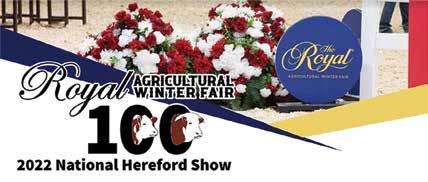

O’SHEA FARMS
and Mel O’Shea DENFIELD, ON 519-477-1238
Pugh MONO, ON
&
Stock
&
Dr. Lois Batty, President – 705-328-4302 www.ontarioherefords.ca
Registered
HIDDEN-VIEW
karen.paszternak@gmail.com
heifers
Trevor
Amy
Wally & Fern lianmor@sympatico.ca · 519-941-8515 Trevor
Amy tpugh27@yahoo.com · 519-939-7489 Breeding
Available
Jamie
osheafarms@hotmail.com Bulls and Females for sale WHISKEY LANE LIVESTOCK Herford and Angus Scott, Paula, Jason and Shelby Cornish INDIAN RIVER, ON 705-295-2925 705-878-3248 (Scott’s Cell) 705-341-3220 (Paula’s Cell) wll@nexicom.net Visitors Always Welcome www.ontarioherefords.ca BILLY ELMHIRST | Indian River, ON • 705-761-0896 • ircc@nexicom.net PRESIDENT JESSICA LASBY | Mulmur, ON • 519-939-0283 • ontarioherefordassociation@outlook.com SECRETARY MANAGER Futurity Show - Thursday, November 3, TBC The National Hereford Show - Saturday, November 5, 8:00am The Ontario Junior Showmanship Classes - Monday, November 7, TBC Contact us for details at nationalherefordshow@gmail.com
ONTARIO
Malcolm Road, Guelph, ON N1K 1B1
and
Phone: 519-824-0334
info@ontariobeef.com
Beck’s Printing Services, Brantford,
ON THE COVER
Late summer and early fall proved to be a busy time for BFO and its members. In August, BFO hosted the Ontario Beef Youth Alliance Summer Tour, as well as the Cow-Calf Management Tour. Then, in early September, BFO returned to Queen’s Park to host its annual beef barbecue for MPPs and legislative staff. This issue of Ontario Beef highlights these activities, as well as a number of helpful resources on livestock transportation and emergency preparedness. The feature article in this issue, submitted by LRIC, provides an interesting perspective on the role of livestock in establishing food security by Dr. Vaughn Holder.
Special thanks to Jeff and Elaine Green from Dundalk, Ontario for our cover photo featuring their Black Angus herd enjoying the cooler nights of fall. Don’t miss out on submitting your photos for our December issue. Please send your winter-inspired photos by November 15 to be considered for the cover. Digital photos in portrait orientation that are at least 300dpi are preferred, and can be emailed to info@ontariobeef.com.
Toll Free (for Ontario callers only) 1-866-370-BEEF (2333)
PROVIDING A FORUM FOR THE ONTARIO BEEF INDUSTRY


Ontario Beef is the official publication of the Beef Farmers of Ontario. Contents of this publication may be reproduced only by permission of the Editor and with credit acknowledged.
Opinions expressed herein are those of the author and/or editor and do not necessarily reflect the opinion of the Beef Farmers of Ontario. Publication of advertisements does not constitute endorsement or approval by Ontario Beef or the Beef Farmers of Ontario of products or services advertised.
Advertising deadlines are January 10, April 15, July 15, September 15 and November 15. The publisher reserves the right to refuse or cancel any advertising, including advertising that is inconsistent with BFO’s Sponsorship Policy, available at www.ontariobeef.com. Every effort is made to ensure the accuracy of material published, however no responsibility can be assumed for advertising not received in clear, type-written form.
Canadian Publications Mail Product Sales Agreement Number 0040007029
POSTMASTER: Return undeliverable Canadian addresses to: Beef Farmers of Ontario, 130 Malcolm Road, Guelph, ON N1K 1B1
EDITOR LeaAnne Wurmli CIRCULATION COORDINATOR Bethany Storey ADVERTISING MANAGER Cathy Lasby, Preferred Agri-Marketing Services Guelph, ON Phone: 519-763-8833 • Fax: 519-763-8833 pams@sentex.net DESIGN and LAYOUT Prism Studios Advertising and Design Inc. Guelph, ON PRODUCTION
PRINTING
ON
BEEF • Beef Farmers of Ontario 130
•
•
Fax: 519-824-9101 •
6 14 CONTENTS 4 Ahead of the Heard 6 The Beef Beat 10 Ontario Beef Market Development Update 12 Rural Ramble 14 Ontario Beef Youth Alliance Gathers for Summer Tour 16 National Leadership Program Names Three Finalists from Ontario 18 OMAFRA Update: Options for Weaning Beef Calves 21 LRIC Update: Future of Global Food Security Depends on Livestock 24 Frequently Asked Questions: Livestock Transportation and the Transfer of Care 27 Emergency Preparedness: A Spotlight on FMD 29 CCA Update 31 Cow-Calf Management Tour Visits Simcoe County 32 Canada Beef Update: Team Canada Competes at 2022 World Butchers’ Challenge 33 Focus on Herd Health: Pinkeye in Cattle 35 Market Information 40 Calendar of Events 42 Farm and Food Care Update OFFICIAL PUBLICATION OF THE BEEF FARMERS OF ONTARIO October 2022 Volume 63, Number 4 COMPLIMENTARY MEMBER-SUPPORTED PUBLICATION BEEF ONTARIO
AHEAD OF THE HEARD
By Jack Chaffe, BFO President info@ontariobeef.com • www.ontariobeef.com
Cross Country Adventures
no idea where the months of August and September went, and here we are at the beginning of October wrapping up corn silage, harvesting beans, planting wheat, attending fall stocker sales, getting cattle off grass and prepping for corn harvest and fall tillage before the snow flies. Sadly, for some of us, it sounds like that may come as early as this weekend for folks in northern Ontario. I am looking forward to a slightly slower pace as we head into the winter months, although the sign of snow always signals “meeting season” for many of us.
Ihave
Let’s go back to mid-August. I, along with a number of BFO Directors, attended the Canadian Beef Industry Conference, which visited Penticton in beautiful British Columbia this summer (and my first time visiting B.C.). Upon arrival, I attended the B.C. Farm Tour, which is always a great way to become acquainted with the area and landscape prior to spending a week in the region. Those of us from Ontario, found it interesting to hear about the connections between farm operations and local land trust and conservancy groups from the local ranchers, which has sparked some investigation by our staff to see if there might be similar opportunities in Ontario to help protect grazing land. As a board member of the Canadian Beef Cattle Check-off Agency, our AGM took place early in the week. Within my role on this board, I’m one of two Canadian producers who sit on the Canada Beef Marketing Committee, which is responsible for planning and establishing Canada Beef’s strategic, business and operational goals and objectives, and for the overall management and operation of the business and affairs. Coming out of the AGM, I was fortunate
BFO BOARD OF DIRECTORS 2022
Jack Chaffe (Feedlot Director) - President
Phone: 519-301-3034 • Email: jdchaffe@quadro.net
Craig McLaughlin (Eastern Director) - Vice-President
Phone: 613-504-1863 Email: cmblackhorse@gmail.com
Don Badour (Cow-Calf Director)
Email: don.badour@ripnet.com
Don Hargrave (Cow-Calf Director)
Email: dchargrave@gmail.com
Jason Leblond (Cow-Calf Director)
Email: jsacres5@gmail.com
Rob Lipsett (Background Director)
Email: lipsettrob@yahoo.ca
Joe Dickenson (Feedlot Director)
Email: joe@dickensonfarms.com
David Millsap (Feedlot Director)
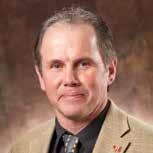
Email: davidwmillsap@gmail.com
Jordan Miller (Northern Director)
Email: b.jordan.miller@gmail.com
Ron Stevenson (Southern Director)
Email: ron@metzgervet.com
Jason Reid (Director-At-Large)
Email: reidridgefarm@tbaytel.net
Kim Jo Bliss (Director-At-Large)
Email: kimjobliss@gmail.com
to be elected as finance chair of the committee for the year ahead.
Throughout the rest of the week, I attended a number of CCA committee meetings, as well as participated in discussions with representatives from the U.S. and Mexico. The most significant action item materializing from the week was the desire for greater emergency preparedness surrounding the potential threat of food and mouth disease (FMD) and the need for a dedicated vaccine bank to help protect Canada’s beef sector should we ever be faced with a case of FMD in the country.
After returning from Penticton, we headed to Kanata, Ontario for our BFO Summer Meeting, which returned to an in-person meeting. It was great to catch up with everyone and provide some timely updates for advisory councillors on BFO activities. Special thanks to Corad Farms, owned by Chad and Sarah Hunt and family for hosting the farm tour portion of our meeting. Despite the rain and drizzle, it was nice to have a return to “normal”.
Speaking of a return to normal, on September 7th we made our debut return to the Ontario Legislature and hosted our 15th Annual Beef Barbecue on the lawn of Queen’s Park for MPPs and legislative staff. We had a terrific day and positive reception from MPPs both at the barbecue and during our individual meetings throughout the day. We sincerely appreciated the support of Minister Lisa Thompson who helped us convene the event, as well as the opportunity to meet at length with Premier Ford to talk about Ontario’s Risk Management Program, the review of the PAWS Act and Canada’s investment in a FMD vaccine bank.
BFO STAFF
Executive Director
Richard Horne • richard@ontariobeef.com
Manager of Policy and Issues
Thomas Brandstetter • thomas@ontariobeef.com
Policy Advisor
Darby Wheeler • darby@ontariobeef.com
Policy Advisor
Evan Chaffe • evan@ontariobeef.com
Director of Communications
LeaAnne Wurmli • leaanne@ontariobeef.com
Manager of Public Engagement and Digital Strategy
Jennifer Kyle • jennifer@ontariobeef.com
Communications Specialist
Bethany Storey • bethany@ontariobeef.com
Market Information Coordinator
Jamie Gamble • markets@ontariobeef.com
Accountant
Amber McIntyre • amber@ontariobeef.com
Office Manager
Tammy Purdham • tammy@ontariobeef.com
Manager of Producer Relations
Dan Ferguson • dan@ontariobeef.com
Senior Producer Relations Specialist
Jaclyn Horenberg • jaclyn@ontariobeef.com
Producer Relations Specialist
Robert McKinlay • robert@ontariobeef.com
Check-Off Inspector
Chris Millar • chrism@ontariobeef.com
Provincial Supervisor, Ontario Feeder Cattle and Beef Breeder Co-op Programs
Cheryl Russwurm • crfeederfin@wightman.ca
Water Quality Specialist
Chris Attema • chris@ontariobeef.com
4 ONTARIO BEEF • OCTOBER 2022
As highlighted in this issue’s edition of Beef Beat, our number one priority with the Ontario government remains as a request to increase investment in the Risk Management Program to provide financial stability for our farmers who are being faced with so much volatility both in the raising and production of beef, but also in the marketplace. To further articulate this needed investment, BFO with our partners in the Ontario Agriculture Sustainability Coalition (beef, grains, horticulture, pork, sheep and veal) invested our own resources and worked with a third-party economist to conduct a study on the economic value and impact of RMP in Ontario. The positive results from this study, which will likely be shared publicly by the time you are reading this, will be used as we lobby for further government investment leading up to the release of the fall economic statement in November.
On September 27-28, I along with Craig McLaughlin, travelled to Ottawa for a CCA Directors’ Meeting where we received updates on traceability, BSE files and transport regulations, to name a few. As MPs are back in Ottawa for their fall session, CCA hosted their “BBQ on The Hill” event which celebrated the front-of-package label victory by serving up double cheeseburgers to the MPs. This event gave CCA Directors a great opportunity to touch base with MPs again.
We now have our sights set on planning our Fall Meeting for our advisory council and committee members in late November in Guelph, and planning is underway for our annual general meeting, which will also return to in-person in Toronto from February 22-23, 2023. Mark your calendar and hope to see you there. OB
Special Meeting: Peel-Halton Cattlemen’s Association
Peel-Halton Cattlemen’s Association is inviting all check-off paying members in the counties of Peel and Halton to attend a special general meeting, which will be held virtually on Tuesday, November 15, beginning at 7:30 p.m. Participants can join by Zoom or by phone.
The purpose of the meeting is to discuss the future of the PeelHalton Cattlemen’s Association, and next steps should the membership vote to dissolve. If a vote to dissolve is carried, the membership will need to discuss what to do with the association’s assets, which county Peel and Halton members will join, and steps to take should members want to join a different county.
At the special general meeting, a majority of the Peel-Halton Cattlemen’s Association members present and voting may pass resolutions for presentation to the BFO Board of Directors, which includes a vote to dissolve should that be the direction from the members present.
To attend the meeting, please call the BFO office to register or use the following link: https://bit.ly/3rhj2Fb OB
FEEDLOT HERD PERFORMANCE TO


The MaxForce™ line of beef premix is designed to help your cattle stay healthy and profitable from receiving right through the grower and finisher diets. Available with Chelated Minerals and B Vitamins for added health and performance benefits.
USE MAXFORCE™ TO GET THE MOST OUT OF YOUR HERD.

To learn more about these products contact your GVF Beef Specialist today or reach us directly at the number below.

ONTARIO BEEF • OCTOBER 2022 5
1-800-567-4400 grandvalley.com Advanced Animal Nutrition for Improved Human Health. TAKE YOUR
THE MAX
THE BEEF BEAT
By Darby Wheeler, BFO Policy Advisor darby@ontariobeef.com • www.ontariobeef.com
BFO Returns to Host Annual Barbecue at the Ontario Legislature



Having started working at BFO in the summer of 2020, my experiences out and about for work had been limited and my experiences at virtual meetings had been higher than ever expected due to the COVID-19 pandemic. But opportunities the past few months to meet producers and engage with other organizations have certainly increased with people eager to get back to meeting in person. This past summer, it was great to be able to attend the firstever Ontario Beef Youth Alliance Summer Tour, the Canadian Beef Industry Conference and BFO’s Summer Meeting in Lanark County. It’s been awesome to meet producers and colleagues from across the province and country, and to gain more insight into the issues impacting the beef sector.
Another first for me since beginning at BFO, and with much anticipation, was taking part in BFO’s Annual Queen’s Park Beef Barbecue. After a two-year hiatus, BFO Directors and staff were excited to be back at Queen’s Park on September 7th for the 15th annual event and lobby day. Likewise, Members of Provincial Parliament (MPPs) and legislative staff were also excited to see the return of the beef barbecue on the front lawn and eagerly lined up to enjoy some Ontario Corn Fed Beef.
A major component of the BFO Queen’s Park Barbecue is engaging with MPPs and discussing timely issues facing the beef sector. Board and staff attended several meetings throughout the day with government and opposition MPPs from all parties represented in the legislature. This included meetings with Premier Ford; Lisa Thompson, Minister of Agriculture, Food and Rural Affairs; Steve Clark, Minister
BFO was pleased to have staff from Feed Ontario join us for our annual barbecue. BFO continues our commitment to Feed Ontario’s beef program through our annual donation. BFO Directors officially presented Feed Ontario with $40,000 to provide ground beef to folks and families in need.
of Municipal Affairs and Housing; and Graydon Smith, Minister of Natural Resources and Forestry. It was a pleasure to meet with each and every MPP to highlight priority issues facing our members while underpinning the value of beef production in the province to our environment and economy.
In addition to discussing the impact of Ontario’s beef sector to the provincial economy and the industry’s environmental goals, priority issues raised with MPPs were investments in Ontario’s Risk Management Program (RMP), a review of the Provincial Animal Welfare Services Act (PAWS Act), and the need for a foot and mouth disease (FMD) vaccine bank. Also discussed with some MPPs was the use of Crown Land for agricultural use in northern Ontario, preserving Ontario’s farmland, and meat processing capacity. To dive further into the key issues discussed with MPPs, below is a brief overview of each issue.
Risk Management Program
Raised during every meeting was the need for increasing the RMP funding cap. As many know, RMP is a cost-shared insurance program designed to help stabilize the grains, horticulture and livestock sectors by providing partial financial protection for Ontario farmers against market volatility and production risks. RMP fills a critical gap for agricultural commodities in Ontario that are not protected by the supply management system. In discussions at Queen’s Park, BFO emphasized that the program is underfunded and for the need
6 ONTARIO BEEF • OCTOBER 2022
BFO wishes to thank Premier Doug Ford for taking the time to meet with our executive team, and to Lisa Thompson, Minister of Agriculture, Food and Rural Affairs for her support in the coordination of the day.
to increase the program cap from $150 million to $250 million. Currently the program is unable to meet all claims and increasing the program cap would ensure it is adequately resourced and responsive to changing market demands.
Provincial Animal Welfare Services Act

BFO CELEBRATES 15TH ANNUAL BARBECUE AT QUEEN’S PARK
BFO returned to Queen’s Park in September to host their 15th Annual Beef Barbecue on the lawn of the Ontario Legislature in Toronto on Wednesday, September 7th for MPPs and their legislative staff. The BFO Board of Directors and staff proudly served an all-Ontario meal featuring Ontario Corn Fed Beef to 500 attendees over the lunch hour.
In addition to this highly anticipated annual event, BFO Directors and staff personally met with numerous MPPs throughout the day to advocate for increased investment in the Ontario Risk Management Program (RMP), a critical program to help protect the provinces food security, and ensure stability for the entire beef sector and for rural and urban communities.
Replacing the OSPCA Act, the Provincial Animal Welfare Services (PAWS) Act came into effect in January 2020, which implemented a provinciallyfunded animal welfare enforcement model to protect animals from abuse and neglect. BFO has a team of animal care advisors who work cooperatively with PAWS inspection staff to provide a beef perspective when it comes to the standards of practice around care and handling of beef cattle. Despite BFO’s positive relationship with PAWS staff, there have been concerns around enforcement practices on farms and removal and seizure of livestock practices. In speaking with MPPs, BFO requested a review of the PAWS Act as it relates to enforcement on farms and removal and seizure of livestock, in partnership with agricultural stakeholders.
BFO appreciated the participation of MPP Sol Mamakwa, NDP Deputy Leader, and MPP John Vanthof, NDP Agriculture Critic, who helped to serve beef to MPPs and legislative staff.

Canadian FMD Vaccine Bank
BFO also raised the need for the Canadian government to fund a food and mouth disease (FMD) vaccine bank. Despite this being a federal issue, it was raised with MPPs to garner awareness. FMD is
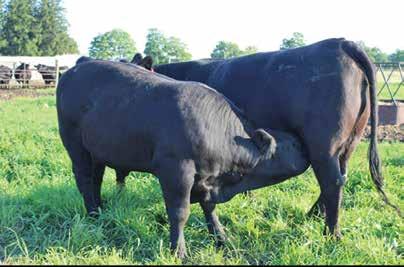
“Farmers, like many sectors, now face unprecedented levels of risk and uncertainty. These risks cannot be mitigated by good management alone due to the increase in cost of production, trade and supply chain disruptions, and a level of market volatility we have never experienced,” says Jack Chaffe, BFO President. “Increasing the investment in RMP is the single most important action the province can take to support Ontario beef farmers with a proven return for the Ontario economy.”
Directors and staff also encouraged government to support a review of farm inspection and enforcement practices employed under the Provincial Animal Welfare Services (PAWS) Act with the farm sector. Preservation of farm and grazing land was another topic of discussion, with directors and staff asking for a commitment to preserve farmland through sound provincial land use policy that sees agriculture lands, including marginal lands used for livestock grazing and carbon sequestration, protected as the best use of our province’s arable land.
“The beef industry is an important economic driver of Ontario’s agri-food sector, contributing $2.69 billion to Ontario’s GDP,” explains Chaffe. “The priorities we shared with government representatives during our lobby day focus on growing beef production and promoting financial and environmental sustainability to ensure we can continue to provide a healthy supply of local food to Ontarians and those around the globe.”
BFO wishes to thank Premier Doug Ford for taking the time to meet with our executive team, and to Lisa Thompson, Minister of Agriculture, Food and Rural Affairs, MPP Rob Flack and MPP Trevor Jones, Parliamentary Assistants to the Minister of Agriculture, Food and Rural Affairs, for generously taking time to serve beef to the barbecue attendees. BFO also appreciated the participation of MPP Sol Mamakwa, NDP Deputy Leader, and MPP John Vanthof, NDP Agriculture Critic, who helped to serve beef.
ONTARIO BEEF • OCTOBER 2022 7
Continued on page 8. 2022 Bull Calves are ready for selection. Reserve Yours Today! We will develop over the winter, semen test and deliver in the spring. FOR DETAILS CALL Allan: 519-375-5541 • Jarrett: 519-374-5516 • Don: 519-375-1500 harprey@gmail.com • 307483 Centre Line A, Proton Station, ON, N0C 1L0
a severe and highly contagious disease that affects clovenhoofed animals such as cattle, pigs, sheep, goats, and deer, and is present or is a growing concern in a number of countries around the world. If detected in Canada, not only would it severely impact the health of animals, it would lead to an immediate border closure to exports from the beef, pork and dairy sectors. A large-scale outbreak in Canada has the potential for a $50-to-$60-billion-dollar financial impact on the Canadian economy. Vaccination is deemed as an important response to an FMD outbreak. Currently, Canada does not have its own FMD vaccine bank, but the projected cost of a Canadian FMD vaccine bank is $3.2 million. A small price tag in comparison to the potential cost of an outbreak in Canada.

Other Priority Issues
Other issues that were raised throughout the day included:
• Fostering growth of the agricultural sector in northern Ontario through access to Crown Land was discussed with many of the MPPs. Specifically, the need to develop an improved mechanism for permitting the use of Crown Land for agricultural use to support economic growth in northern Ontario;
• Preserving farmland to support the environment and food security was also discussed with an emphasis on preserving Ontario’s agricultural grasslands and recognizing the environmental benefits grasslands provide; and




• Committing to increase investment in programs that support meat processing capacity and infrastructure, and address labour challenges in the meat processing sector. BFO acknowledged the significant investments made by both the provincial and federal governments to support meat processing in Ontario, but noted the issue persists. BFO provided recommendations to improve funding
Title sponsor:

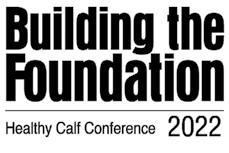

8 ONTARIO BEEF • OCTOBER 2022
Join us for Ontario’s premier calf event! How to register: All-Canadian speaker line-up!
Supported and sponsored by:
Continued from page 7. – The Beef Beat
MPPs and legislative staff enjoyed an all-Ontario lunch featuring Ontario Corn Fed Beef striploin on a bun and hearty salads.
Canadian Angus Bulls
Maximize your marketing by buying Canadian Angus bulls and participating in the Canadian Angus green tag program. When you buy your Angus bull, insist on the registration papers, and be sure they are transferred in your name.
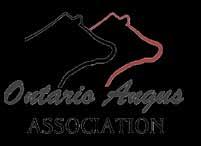

Canadian Angus cattle present a balanced genetic profile in terms of calving ease, growth, and quality carcass merit. They are versatile animals that work well in both purebred and crossbreeding programs.
When Canadian Angus bulls are used in crossbreeding programs they contribute to low birth weights, valuable maternal traits, and moderate frame size to replacement heifers.
any of the breeders below to arrange for
Farms
Company
Farms
Windcroft Farms
Line Farm
Glen Islay Angus
Worth-Mor Cattle
ONTARIO BEEF • OCTOBER 2022 9 Cambray Livestock
Luke, Matt, Joe and Carl Jewell 1153 The Glen Road Woodville ON 705-934-2853 Fallis Land and Cattle Mike, Lisa and Cole Fallis 1273 6th Line Selwyn, ON K9J 6X5 705-740-4878 sunsetacres@nexicom.net Gilchrist
Brad & Kristie Gilchrist 1269 Grey Ox Ave RR#5 Lucknow, ON N0G 2H0 519-440-6720 brad@gilchristfarms.com
Don Currie 2234 Conc 11 Nottawa, ON L0M1P0 705-715-2234 doncurrie@glenislay.com Harprey
Allan Hargrave/Don Hargrave 307483 Centre Line A Proton Station, ON N0C 1L0 Allan 519-375-5541 Don 519-375-1500 harprey@gmail.com Loval Farms Scott & Sandra Honey 127 Honey Road Warkworth, ON K0K 3K0 705-924-3809 lovalfarms@gmail.com Maple
Ian & Tim Rudkin 3320 Bradburn Road Blackstock, On L0B 1B0 Ian 905-718-5331 Tim 905-213-6518 maplelinefarm@hotmail.com Meadow Bridge Angus JJ Deslippe 922580 Rd 92 RR # 4 St Mary’s, ON N4X 1C7 519-275-1739 deslippe@quadro.net Rob Roy Angus Don & Betty McNalty 634514 Road 63 RR#2 Singhampton, ON N0C 1M0 705-446-4740 robroyangus@gmail.com SCOMAC Livestock Scott & Elizabeth MacDonald 4169 Highway # 6 Hagersville, ON N0A 1H0 Scott 519-820-1272 Elizabeth 226-971-0015 scomaclivestock@gmail.com Silver Springs Farm James, Joan and Robert McKinlay 609027 12th Sideroad RR#1 Ravenna, ON N0H 2E0 519-599-6236 jmckinlay@bmts.com Tullamore Farms Bill & Sylvia Jackson 12201 Torbram Rd Caledon, ON L7C 2T4 Home 905-843-1236 Cell 647-990-2697 tullamore.angus@gmail.com Upper Glen Angus Rick Stull 12249 8th Line Georgetown, ON L7G 4S4 905-703-0503 rickstull93@gmail.com Whiskey Lane Livestock Scott, Paula, Jason & Shelby Cornish 2295 Hwy 7 Indian River, ON K0L 2B0 705-341-3220 wll@nexicom.net
Darcy & Courtney McMorris 573333 Boot Jack Ranch Road Priceville, ON N0C 1K0 226-203-4506 windcroftfarms@gmail.com
Kyle, Rachel, Jordyn and Mason Petherick 950 County Rd 8 Campbellford, ON K0L 1L0 705-768-3560 worth-mor@hotmail.com Contact
your private viewing of cattle for sale.
and the Green Tag Advantage Visit the Ontario Angus Association website for more information and to find listings of Ontario purebred sales: www.cdnangus.ca/ontario-angus-association
ONTARIO BEEF MARKET DEVELOPMENT
By John Baker, Director of the Ontario Beef Market Development Program john@ontariobeef.com • www.ontariobeef.com

Morton’s Foodservice Introduces Grass Roots Ontario Beef Program
the Morton’s Foodservice new, Grass Roots Ontario Beef program, which is sourced from beef raised on Ontario family farms and processed at Ontario facilities.
Introducing
Morton’s Foodservice is an Ontario-owned independent distributor that supplies over 6,500 food and beverage and restaurant supply products to some of Ontario’s finest restaurants.

“The foodservice distribution industry in Ontario is dominated by very large U.S.-owned broad line distributors,” says Jean Beauchemin, Director of Marketing at Morton’s. “Because of the high-volume scale of these operations, imported beef dominates this sector and locally sourced products are often not available.”
“We see our partnership with Ontario Beef as a long-standing mutually beneficial relationship. It is an opportunity to further define a competitive advantage against our major competitors by developing a locally sourced beef program that features high-quality Ontario beef, raised on Ontario family farms and processed in Ontario,” adds Beauchemin.
“This program also provides an opportunity to help us work better with Ontario packers by clearly outlining what process and claims we must deliver. Due to our smaller scale, it is important we move away from selling on price and strictly commodity beef.”
Morton’s have identified several important attributes that help to differentiate their brand. Documented quality assurance programs are an important aspect of ensuring the attribute claims are verifiable.
The Ontario Corn Fed Beef Quality Assurance program provides the verification process required to validate the claims. They also work closely with VG Meats as a supply chain partner to provide verification on specific claims.
“Working with our partners provides open lines of communication to assist the supply chain partners to work together to sell more Ontario beef,” says Beauchemin.
Morton’s Foodservice is known for their friendly and easy-to-deal-with personal approach. Most of the sales team is made up of trained chefs and former restaurant managers, which provides an ability to relate well to their customers and serve the needs of the independent foodservice community.
As an Ontario company, Morton’s believes it is important to support their local communities and Ontario’s economy. Supporting local farmers and food processors is an aspect of their commitment to social responsibility.
Their Ontario Grass Roots Program is designed to minimize the environmental impact of food distribution in the province. By purchasing products made and grown in Ontario, Morton is able to decrease overall transportation requirements, reduce the use of fossil fuels and lower their carbon footprint. They’re able to provide superior quality Ontario products while building strong relationships throughout the supply chain.
ONTARIO BEEF
“What’s more, products grown closer to where they are consumed taste way better,” says Beauchemin.
Morton’s sees their role as an important one to ensuring high quality locally produced foods are made available to independent restaurant operators. Their geographic market spans from the Niagara region in the south to Lake Huron in the north and west to Windsor.
“Our role is to act as an ambassador to promote and facilitate the relationships between Ontario farmers and processors, and the independent restaurant community. We work on relationships in this unique segment every day,” explains Beauchemin. “At Morton’s Foodservice, it is important to us that we support the communities and businesses where we live, work, and play.” OB
10 ONTARIO BEEF • OCTOBER 2022





David Banbury, President - 519-729-6825 email: drbanbury@gmail.com Follow us on Facebook and check our website for current news at www.ontarioshorthorns.com SHORTHORN FEMALE GET YOUR NEXT AT THE FALL CLASSIC SALE! CATALOGUES Please check www.ontarioshorthorns.com/sales or contact Blair Williamson: ridgeviewshorthorns@hotmail.com • 519-808-0516 Don’t miss the National Shorthorn Show at the RAWF – Sunday, November 6th at 2:30pm Emerson Clarke Memorial Junior Shorthorn Show – Monday, November 7th at 10:00am Saturday, November 19th, 2022 Maple Hill Auctions - Hanover, Ontario Pictures are highlights from the 2021 sale.
RURAL RAMBLE
By Dan Ferguson, Manager of Producer Relations dan@ontariobeef.com • www.ontariobeef.com
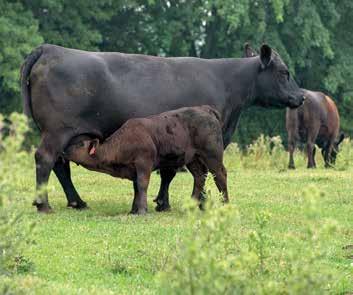



Helpful Support
This edition of Rural Ramble highlights various tools that can benefit our producers including social, financial, and production-focused tools. It is often challenging to get producers to use the tools that are available for their own benefit and that of their business. This past spring, the same could be said for getting a cow to use the headgate for her, her calf and the business to benefit.
Half way through the calving season, I observed a usually goodnatured cow (29G) progressing with her delivery part way down the hillside in my calving yard. On closer inspection, only one foot was presenting and she was restless, up and down, and not getting down to business. The headgate is up closer to the barn, but it may as well have been at the other end of the farm. If I take a pail of feed out to coax her, I get the attention of ten of the wrong cows and create a fight for a treat. I cautiously approached, crouched down, so she couldn’t see me over her side when she would strain. My stealthy plan proved successful as I was able to get my obstetric chain on the foot and check further. There was a nose but the other foot wasn’t
close so she would need help. But before I could proceed further, she jumped back up and swung around to face her menacing midwife. I had already taken off my soiled windbreaker and discarded it in the sod mud mix of the yard. She vocalized an aggressive message in my direction and added some angry head bobs as she lunged towards me. I back tracked quickly as she charged, but her focus changed to my coat sleeve that had some of her embryonic fluid on it and she seemed attracted to that.
A ”light bulb moment” is rare these days but I had the most brilliant idea. I could use the coat as bait. It was a bovine dance of tease and follow as I used her pre-delivery delirium and the scented coat sleeve to work her step-by-step to the headgate area. Not that BFO would endorse such risky behaviour, but I did manage to coerce her to the gated area near the chute. Once I had her caught and restrained, as most vets would agree, the rest was text book. Having short arms, I was unable to push against her strains and bring the down foot up to allow for delivery. My son lives very close and was at chute side in five-minutes and used his long arms to right the calf’s position and together we presented a live calf to a very maternal mother who thankfully forgot about my soiled coat.
The headgate and chute system, like many tools and programs, is only good if we use them. Half the battle is applying the right tools to the job to make it more profitable, easier, welfare-friendly or socially satisfying. In my case, more work has to be done to easily move cattle to the headgate that need it, and take advantage of that tool. As to the various programs BFO outlines, please be sure to ask questions, get information, and try to use as many tools to help you and your farm succeed and move forward.
12 ONTARIO BEEF • OCTOBER 2022
OB
No one ever regretted buying quality. DON & JEANNETTE CURRIE 2234 Conc. 11, R R #1, Nottawa, Ontario L0M 1P0 Phone/Fax: 705-445-1526 Cell: 705-715-2234 • Email: doncurrie@glenislay.com
GLEN ISLAY
LENA 36J Our bull calves are weaned and ready for selection. Remember we always sell out of bulls by private treaty, so reserve you bulls now and we will semen test them and deliver them when you want them. This bred heifer and five others sold in the Blue Water Sale on October 15 in Cargill Ontario.
LARGE ANIMAL HANDLING SAFETY








For the most part, large animals are peaceful. If left to themselves they will not seek out situations to do you harm. That said, one in five injuries on Canadian farms are livestock related and 50% of those are due to human error. By understanding animal behavior, being mindful, and following some basic rules, we can prevent injury.
For starters, cattle and horses are sensitive to sudden movements and loud sounds and may startle and jump, or move away quickly. You can be crushed if you happen to be in their path.
Be Aware of Flight Zones and Blind Spots






It is crucial that we understand an animal’s flight zone. This is the animal’s personal space and it is the distance from an animal that we must maintain for the animal to feel comfortable and unthreatened. Entering the flight zone will cause an animal to move away and if there is no place to move, it may react aggressively to you.
Understanding an animal’s point of balance enables us to use the flight zone strategically to move an animal one way or the other. For example, if you approach a cow from behind her shoulder, she will move forward; approaching her from in front will cause her to move back.

The blind spot is the area directly behind the cow or horse. Standing in the blind spot will make it feel uneasy, confused and possibly endangered. This could result in a kick. Be aware of an animal’s kick zone and be sure to stay out of it. If you have any visitors to the farm who are unfamiliar with large animals, sharing the importance of staying out of their kick zone is important information.
When working with or near cattle or horses always have an escape route, especially when you are in a location that is walled or has any other kind of barrier. You may be doing everything right. But if the animal is startled, by the wind flapping a bag for example, you need to have an immediate escape route should it become spooked.
Take Special Care with Bulls and Horses
It must be stated that while great care needs to be taken around cows and horses, bulls represent a whole other level of danger. Bull attacks account for over 40% of all livestock fatalities on Canadian farms with only one in twenty victims surviving a bull attack. Bulls are territorial and may aggressively attack you if you invade their space, especially if there is a cow in heat or if they are fighting another bull.
Horses can kick you with their front and hind hooves if they are startled or angry. They will also bite their handlers if they are annoyed because you are asking them to do something they don’t want to do.
Many horse related injuries occur when a rider falls off the horse. Sometimes the horse bucks, or bolts because the horse is startled by noise or the wind, and the rider is thrown off.



Let’s not forget about the back pain caused by mucking out pens. It’s important to always use correct lifting techniques –bending at the knees and not twisting your spine when lifting. Trimming hooves regularly can also cause back pain. As with any process that is done repetitively, it is important to take regular breaks and do stretching.

An Abundance of Patience
Large animals will remember a bad experience for a long time. If your animals aren’t loading into the trailer and doing what you want them to do, yelling and hitting them will only make the situation worse.
We need to remember to have an abundance of patience working with them. Take your time. Move slowly and speak softly and your animals will treat you decent too.
OMAFRA is providing funding to Workplace Safety & Prevention Services to deliver resources and consulting services to help farmers and other agri-food businesses provide safe workplaces.
The Canadian Agricultural Partnership is a five-year, $3 billion investment by federal-provincial and territorial governments to encourage innovation, competitiveness and sustainability in Canada’s agriculture industry.
ONTARIO BEEF • OCTOBER 2022 13
Call Customer Care to speak with a consultant. 1 877 494 WSPS (9777) customercare@wsps.ca
For free online resources relating to animal handling including our capsule video series, visit: https://engage.wsps.ca/ag-lrg-animal-handling-2022
Ontario Beef Youth Alliance Gathers for Summer Tour
 By Robert McKinlay, BFO Producer Relations Specialist
By Robert McKinlay, BFO Producer Relations Specialist
At the beginning of August, two years of planning and delays finally paid off as BFO hosted the first Ontario Beef Youth Alliance (OBYA) Summer Tour. The Ontario Beef Youth Alliance is a network established by BFO to support and encourage the next generation of beef farmers. The alliance is comprised of individuals who are between the ages of 18 to 35 who are actively involved in the Ontario beef industry.
The tour began Friday morning at Kawartha Ethanol, a corn ethanol plant with a capacity of 80 million litres of fuel-grade ethanol production each year. The by-product of this production is high-quality distillers’ grains which are used in the local feed industry. This facility produces 40,000 MT of wet distillers’ grains and 45,000 MT of dried distillers’ grains. During the pandemic, the plant expanded into the production of higher-grade ethanol for use in hand sanitizers, pharmaceuticals, and beverages.
Kicking off the tour with a visit to Kawartha Ethanol, a corn ethanol plant with a capacity of 80 million litres of fuel-grade ethanol production each year.
We grabbed lunch on our way to Enright Cattle Company, and arrived at Don and Chris Langevin’s farm, who operate a backgrounding and finishing operation that produces calves which are then marketed through their daughter’s (Kara Enright) abattoir and store. Don discussed their feeding program which utilized distillers’ grains from Kawartha Ethanol and farm-grown feed. We toured Langevin’s feedlot barns, as well as their outdoor yards which they use to background calves on year-round. We then had the opportunity to tour their state-of-the-art handling facility and discussed their quality assurance system that tracks meat withdrawals and treatments in the feedlot.
We then moved to the Enright home farm. Kara and Darold Enright, along with their son Corben and daughter Evelyn, operate Enright Cattle Co., which raises purebred red and black Simmental cattle and operate a birth-to-beef operation through a local abattoir they recently purchased. All livestock are raised on a natural diet without the use of added hormones, and a complete traceability system has been implemented. This allows them to trace cuts to individual cattle and aids in their breeding and buying decisions. We had the privilege of seeing their cow herd and their replacement heifer yard. They employ an artificial breeding program on a percentage of the herd to
True to the farmer spirit of using what you have, the Enright’s constructed an on-farm store using an old steel grain bin. This on farm store became a destination for customers near and far during the pandemic to visit and shop.

pursue carcass trait bulls to supply high-quality cattle for their direct marketing business. We also had the opportunity to view their line of high-quality leather products in their on-farm store. True to the farmer spirit of using what you have, the Enright’s constructed an on-farm store using an old steel grain bin. This on farm store became a destination for customers near and far during the pandemic to visit and shop.
A short jog up the road, we then arrived at Donecho Farms, which is run by Bruce and Jacob Palmateer and family. The farm has a feeding capacity of 1,200-head and calves out 160 commercial cows. Jacob is the current OBYA representative on the BFO Feedlot Committee, and the Palmateer family is actively involved in the Beef Farmers of Hastings County. Jacob and his father Bruce discussed their relationship and how they worked together when Jacob returned to the farm after working away. Both Palmateers discussed the importance of listening and respect for one another as their farm was in transition. The Palmateer farm is very unique in its ability to utilize natural features, such as flat rock in its feed storage and barn construction. They have also been able to utilize pre-owned buildings
14 ONTARIO BEEF • OCTOBER 2022
The group was graciously hosted for a tour and supper at Donecho Farms, which is run by Bruce and Jacob Palmateer and family. The farm has a feeding capacity of 1,200-head and calves out 160 commercial cows.



and relocate them to the feedyard to keep their yardage costs low. Bruce explained his desire to have flexible barn layouts that allow him to change pen sizes and handling systems through the use of concrete blocks and yard panels.
The group moved to Jacob’s shop for supper which was generously provided by the Palmateer family. After a delicious Ontario Corn-Fed steak and amazing side dishes, we had Colleen Acres from the Ontario Soil and Crop Improvement Association speak on the new On-Farm Climate Action Fund (OFCAF) program. Colleen explained eligible projects and the possibility for young producers to source funding for new management or expansion projects. We then departed Palmateers for our hotel in Belleville in preparation for our second day of tours.
Saturday morning, we ventured across the bridge into Prince Edward County. We arrived in the heart of wine country at Baitley Farms Ltd., which is run by John and Kathy with their son Curtis and daughter Melissa. Baitley farms encompasses 1,800 acres of corn, soybeans, wheat and hay. They have a 70-head commercial Simmental cow herd and have a 500-head backgrounding facility with a new 200-head fabric structure. The feedlot is certified with the Ontario Corn Fed Beef Program. Curtis discussed their crop rotations and how they utilize drought resistant forage crops to ensure they have
In the heart of wine country, the group stopped at Baitley Farms Ltd., which is run by John and Kathy with their son Curtis and daughter Melissa.
sufficient feed for their cattle. Curtis showcased their new barn with feed rails they custom designed for easy adjustment. Melissa and Curtis discussed how they balance family and the farm, playing to each other’s strengths. We also visited with Allie Pennings, who is a local cow-calf producer who helps the Baitley family. Curtis emphasized the importance of good help on their operation and the variety of tasks expected of them. The Baitley’s discussed their low stress arrival protocol where calves are allowed to settle before being processed. They attribute this and the environment they are able to create in their barns to their low pull rates and performance.
On behalf of BFO, we would like to thank all the OBYA members who were able to come out for our first summer tour. We would like to thank all of our generous farm hosts who opened their doors to our group and took time out of their busy schedules to showcase their operations. The tour was an amazing knowledge sharing opportunity as we were able to see a variety of effective management practices in the different sectors of the beef industry. We would also like to thank the sponsors that allowed us to put on such an amazing event. We look forward to continuing to meet and create new learning opportunities to continue to improve the future of our industry. OB
National Leadership Program Names Three Finalists from Ontario
By Bethany Story, BFO Communications Specialist
The Canadian Cattle Young Leaders Program provides industryspecific training and mentorship to assist individuals, and the beef industry, in building leadership capacity across the country. This program provides opportunities to learn from industry leaders through mentorship opportunities and participation at various events. Young industry enthusiasts between the ages of 18 and 35 have a chance to participate in discussions at provincial, national and international levels that define the direction and future of the Canadian cattle and beef industry.
Semi-finalists from across Canada travelled to Penticton, B.C. in August for the final selection process, as well as the chance to participate in the Canadian Beef Industry Conference. Roundtable discussions were held where semi-finalists shared their ideas and insights on topics and issues facing the Canadian beef industry such as succession planning, animal health innovation and production efficiencies, adopting new technology, beef sustainability, growing market shares and much more. Each of the roundtable discussions were facilitated and judged by the program sponsors.
BFO is excited to congratulate Ontario’s three finalists - Madison Lewis of Meaford, Danika Mayer of Alexandria, and Holly McGill of Listowel - who qualified for the Canadian Cattle Young Leaders Program. All three of these young leaders are strong members of the beef industry, whether through 4-H involvement, breed associations or industry committees, providing a great example of how to be involved within Ontario’s beef industry. BFO is proud of these finalists who represent Ontario’s passionate young leaders and look forward to seeing what the future holds for them.

Madison Lewis Grey County
I grew up in the small agriculture town of Meaford, Ontario. 4-H sparked my passion for agriculture, leading me to the University of Guelph – Ridgetown College where I received an Associate Diploma in Agriculture. There, I focused my studies on livestock production, more specifically ruminant nutrition.
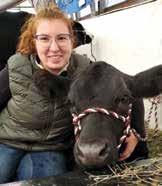
I have continued my studies and am now currently attending the University of Guelph and in my final semester of my Bachelor of Science Honours in Agriculture. I look forward to pursuing my Master of Science in Beef Nutrition upon completion of my bachelor’s degree. I recently graduated from both the Ontario Junior Limousin Association, as well as the Canadian Junior Limousin Association, where I held several positions such as president and treasurer. I am currently an active member of the Ontario Beef Youth Alliance, as well as the director and promotional chairman of the Ontario Limousin Association.
I am extremely honoured to be chosen as a finalist in the Canadian Cattle Young Leaders Program. I am looking forward to working alongside my mentor through the nine month mentorship program and getting the tools to effectively promote the beef industry to consumers.
Danika Mayer Stormont, Dundas and Glengarry United Counties

Despite not having been born into a farming family, I have been involved with agriculture for the better part of my life. I grew up in L’Orignal, Ontario where I took horseback riding lessons at a farm down the road. This farm also included poultry and sheep which sparked my love for farm animals. My family and I moved to a hobby farm when I was 12 years old, and I finally had the chance to own horses and other farm animals. The first bovine on our hobby farm may not have been a beef breed, but my love for cattle flourished from here. I was approached by a local farmer to show his purebred Simmental calves in our local 4-H club and have been hooked since. I am now a registered practical nurse at our local rural hospital, and with the help of my boyfriend we currently calve out 20-head of purebred Simmentals and produce seedstock for our commercial and purebred clients. We currently have plans to expand our operation and eventually we hope to be able to farm full-time.
I am extremely privileged to have been selected as a finalist for the Canadian Cattle Young Leaders Program. I hope to make lasting friendships and am fortunate to have already met so many likeminded individuals from across the country.
Holly McGill Perth County
I grew up in the GTA – with a mother terrified of animals and a father who’s allergic to anything with pollen or fur. I was about as far from the farm life as a person can get. But I have always loved animals, and it only took one day of classes at Guelph to know that agriculture was my calling. Having completed a Bachelor of Science in Agriculture and a Master’s degree in ruminant nutrition at Guelph, I now work as a nutritionist, focusing on beef and veal. I’m a passionate supporter of agriculture and sit on the board of directors for Farm and Food Care Ontario. I am an active member of the new Ontario
16 ONTARIO BEEF • OCTOBER 2022
Beef Youth Alliance and am always looking for ways to increase my involvement within the Ontario beef industry.
To say that I am honoured to be a Canadian Cattle Young Leaders finalist is an understatement; as someone who didn’t grow up in agriculture, I am always blown away by the industry’s willingness to welcome new people to the industry. I’m looking forward to working closely with my mentor to improve my practical and applied on-farm skills, and bring that knowledge back to better support Ontario’s beef sector.
BFO continues to appreciate the enthusiasm and passion displayed by the Canadian Cattle Young Leaders finalists! Their interest and engagement within the industry is encouraging to both young producers, and enthusiasts in general who wish to become more involved.
Are you passionate about the Ontario beef industry and between the ages of 18-35? Join the Ontario Beef Youth Alliance - a powerful group of individuals with energy and enthusiasm to grow, protect and advocate for Ontario’s beef industry. To learn more about the OBYA and the benefits of joining visit www.ontariobeef.com OB

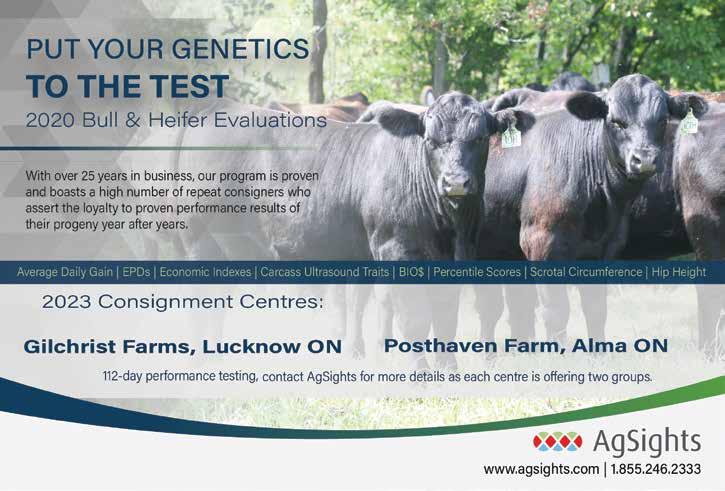
ONTARIO BEEF • OCTOBER 2022 17
OMAFRA UPDATE
Options for Weaning Beef Calves
By James Byrne, OMAFRA Beef Cattle Specialist
time is a stressful period for the calf, cow and beef producer. When separated abruptly, cows and calves vocalize continuously for several days after the event and spend most of their time pacing back and forth, rather than eating and resting. This stress behavior has a negative effect on calf performance, depressing immunity and leaving freshly weaned calves at greatest risk from bovine respiratory disease. Additionally, the constant pacing and lack of feeding can cause significant weight loss in newly weaned calves. The popular idea from the 1970’s to put big distance between calf and cow at weaning has been shown to give no improvement to this stress response.
Weaning
Although it’s well known that abrupt weaning has a negative impact on calf performance post weaning, it is still practiced by 54 per cent of Ontario producers, while 22 per cent favor fence line weaning and 15 per cent use nose paddles or two-stage weaning. The most common months for weaning calves in Ontario are between October and November with most calves sold off farm shortly thereafter. Additionally, the average weaning weight for steers and heifers combined in Ontario is 663 lbs.
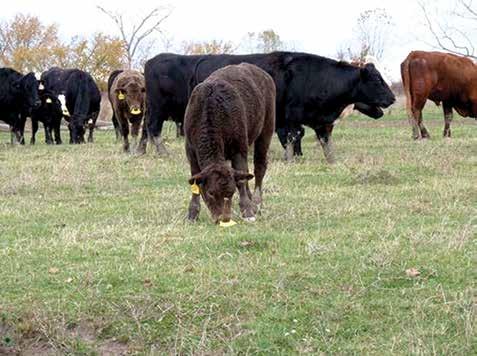

Research by Stookey et al, (1997), and Price et al., (2003), showed that fence line weaning reduced vocalization, reduced pacing, maintained intake and increases average daily gain. In studies comparing average daily gain of abruptly weaned calves to fence line weaned calves, fence line weaned calves gained 95 per cent more than abruptly weaned calves and abruptly weaned calves had not regained that lost weight 10 weeks later. The researchers also observed that fence line weaned calves graze together and would gradually move further and further away from the fence when grazing over the course of the weaning period. This observation is consistent with the theory that social bonds between calves are strengthened at weaning and that calves tend to act as a unit.
Based on the research from Price et al., it is recommended that where fence line weaning is practiced, fence line contact between dam and calf be provided for a minimum of seven days post weaning. On farm, this can be done by placing cows and calves in adjacent fields where they have line of sight of each other or into adjacent pens, if indoors. Where fence line weaning will be practiced outdoors it’s necessary to ensure that the fence between cows and calves is in very good condition and that any electric fence wires are hot. Initially cows and calves will spend a lot of time standing by the fence close to each other. However, over the course of a few days the calves will gradually move away from the fence and show less interest in their mothers. At this point, cows can be moved away in their grazing rotation. To
maintain calf performance, it’s important the calves have access to high quality pasture. Pasture can also be in the form of a simple cover crop such as oats. Given the fact that most Ontario calves are weaned in October and November this may not be available. In the indoor situation, it is very important that freshly weaned calves have access to the highest quality hay on the farm. Access to creep feed is also beneficial and an excellent way to bunk train young cattle. Bunk trained calves are easier to acclimatize to the feedlot environment.
An upgrade to two-stage weaning offers some significant advantages over fence line weaning. Two-stage weaning involves the application of nose flaps to calves to be weaned, before separation from the dam to prevent suckling, (stage 1) followed by separation of the calf from the dam, (stage 2). There is evidence that completing the weaning process in stages – preventing suckling followed by separation sometime later – rather than simultaneously, reduces the stress of weaning greater than that observed by fence line weaning. The research demonstrated that when nose flaps are initially applied to calves to prevent suckling, those calves spend a greater amount of time closer to their mothers compared to calves suckling normally. However, after three days this desire for close contact gradually declines. Two-stage weaning appears to mimic the natural weaning process.
Where two stage weaning is to be practiced, calves should be vaccinated against respiratory diseases at least two weeks prior to the application of nose flaps. The application of the nose flaps, although quick and relatively easy, requires calves to be restrained,
18 ONTARIO BEEF • OCTOBER 2022
Figure 1. Calf nose flaps significantly reduce weaning stress, (Photo courtesy of Nancy Noecker)
Continued on page 20.
CLUB

CHAROLAIS BULL CALF FUTURITY THURSDAY, NOVEMBER 3, 2022 10:30 AM | RAWF, TORONTO, ON SHOW

IN PRIZE MONEY ON OFFER
NATIONAL CHAROLAIS SHOW FRIDAY, NOVEMBER 4, 2022 10:00 AM | A BOSS SHOW SALE
NATIONAL CHAROLAIS SALE FRIDAY, NOVEMBER 4, 2022 7:00 PM
THE SALOON ROOM
|
$50,000
CHRIS POLEY: 306-220-5006 BEN WRIGHT: 519-374-3335 SHANE MICHELSON: 403-363-9973
which is a stressful event in of itself. Calves should wear the nose flaps and remain with their mothers for at least five days. Research by Haley et al., (2005), showed no significant average daily gain differences between calves separated after five days compared to calves separated after 14 days. Calves should be provided with access to the best quality hay and creep in order to maintain average daily gain. In a grazing situation the use of a creep fence or gate can be very beneficial. A creep fence or gate will allow calves to access fresh ungrazed pasture while permitting calves easy access back to their mothers. Nose flaps are cheap, easy to apply and are reusable after proper disinfection. They have about a 95 per cent retention rate.
Preconditioning is a term used to describe a set of management practices for setting up calves to transition from the cow-calf environment to the feedlot environment. In general, this involves ensuring calves are dehorned, castrated, bunk trained and vaccinated prior to sale. Although sometimes not required by some presale programs, proper weaning prior to sale is a critical part of the preconditioning process. Mcartney et al, (2003)., showed that calves weaned using low stress protocols and vaccinated had a reduced risk of treatment for BRD (bovine respiratory disease) in the feedlot compared to unvaccinated, abruptly unweaned calves.
In 2018, a Special Calf Sale Study (2018, OMAFRA, unpublished), showed that the average premium for calves sold through a special calf sale was between six per cent and eight per cent over the local regular calf sale. Special calf sales are sales where calves must meet specific preconditioning protocols in order to participate in the sale. It can be extrapolated, with some reservations, that calves


preconditioned properly, which includes using low stress weaning protocols, would attract a similar premium at a regular calf sale. For the purposes of the 2018 study, it was not possible to compare preconditioned calves versus calves that were not preconditioned presented for sale in a regular sale as that level of data detail was not available.
Proper weaning protocols are necessary to minimize stress on calves, reduce the risk of disease, maintain performance and attract a premium price when presented for sale. Abrupt weaning may be the most common type of weaning practiced in Ontario but causes a lot of stress to calves and very poor post weaning performance. Fence line weaning is the minimum weaning protocol producers should use. However, practicing two-stage weaning protocols should be the aim and aspiration of all cow-calf producers. OB References available upon request.


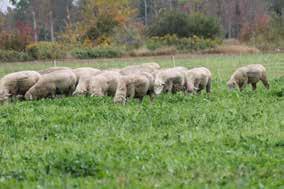
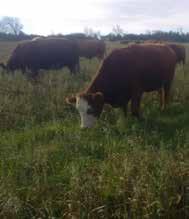
20 ONTARIO BEEF • OCTOBER 2022
Continued from page 18. – OMAFRA Update GRAZIN G COVE R CRO P BENEFIT$ : TH E REA L STOR Y Zoom Webinar Sessions featuring speakers from across Ontario and Canada who have implemented cover crop grazing on their farm. November 8th & 15th - 7:00 PM - 8:00 PM Visit www.ontariobeef.com to register!
RESEARCH UPDATE
Future of Global Food Security Depends on Livestock
 By Lilian Schaer for the Livestock Research Innovation Corporation
By Lilian Schaer for the Livestock Research Innovation Corporation
Given the many pressures facing the livestock industry today, it can sometimes be easy to wonder whether the future of food production in the world will include animals.
Absolutely, says Dr. Vaughn Holder, Research Project Manager in Beef Nutrition at Alltech. Despite admitting his obvious bias given his work in the industry, the data around the importance of livestock for future food security and climate change mitigation is unequivocal - it won’t happen without animal agriculture.
“We usually talk about 2050 and producing enough food to feed the world in 2050, but that’s the wrong conversation,” Holder said while presenting at a Horizon Series webinar hosted by Livestock Research Innovation Corporation (LRIC) on September 13. “How we are going to feed the people of the world right now is the right conversation.”
That’s because population protein intakes and associated environmental metrics for the world’s 205 countries and territories are based on gross protein, which doesn’t account for digestibility or amino acid composition of that protein, both key to meeting human nutritional needs.
When those additional parameters are considered, only about one third of those countries and territories are protein secure with two thirds having a protein intake – mainly plant-based and plants proteins are less digestible to humans than animal proteins – that is below required levels, which Holder calls “quite terrifying”.
“That’s why we need to think about food security right now and any conversation about increasing sustainability by reducing livestock production is quite irresponsible,” he says. “We don’t need more calories; we need more nutrients.”
According to Holder, when protein intake is corrected for those additional parameters, it also changes the conversation around other issues facing animal agriculture, such as land use, fresh water and greenhouse gas emissions.
For example, the amount of land used to grow grains is much less when only gross proteins are considered, but when digestibility and amino acid composition are taken into account, the amount of land used by livestock and grain production is comparable. The same is true of greenhouse gas emissions and water use.
And that’s why the answer isn’t as straightforward as simply proposing the elimination of livestock agriculture, Holder notes.

“When we talk about making changes to our food systems, these are very complex systems and we have to understand what their knockon effects are,” he says. “Given that half of the world’s countries and territories are deficient in protein, any conversation around societal intervention that results in a reduction of food production around the world is extremely irresponsible.”
Only about four per cent of the world’s land is suitable for growing crops, and that’s not enough to feed the world’s population. Cattle are the only animals able to consume and digest poorer quality plant-based feeds from pastures for example and turn it into protein. And even monogastric livestock like poultry and pigs can be fed a balanced diet using corn and soybeans, for example, that will result in more protein than if the same corn and soybeans were consumed directly by people.
“Livestock, particularly ruminants, serve a very important role in improving protein availability for humans. They let nutrients enter our human food system that normally wouldn’t, like grasses, leaves, crop residues, fodder crops, oilseed crop and by-products,” he says. “Taking that away is irresponsible given where we are with food sufficiency.”
United Nations data suggests 86 per cent of global livestock feed is inedible to humans so livestock is performing a service by keeping all that human inedible feed out of the plant carbon cycle. Feeding
by-products to dairy cows creates less greenhouse gas emissions (70 grams of CO2 equivalents per kilogram of by-product) than composting those products (328 grams) or sending them to landfill (3448 grams), for example.
Another important consideration is that reducing meat production in North America – which is one of the most efficient regions of the world in which to raise beef – doesn’t reduce global meat demand. In fact, all it will do is shift meat production elsewhere where it may well have a much higher carbon footprint, effectively causing emissions from meat production to increase.
At the same time, replacing food production with food processing – the creation of plant-based meat, milk, and egg products – is not bringing new protein into the human food system, but rather just creating new uses for existing ones.
“So how do we increase food production in face of protein insecurity but reduce greenhouse gas production? It’s not all doom and gloom –it’s about using the resources and the knowledge that we have,” he says.
If the world were to apply what is known about efficient livestock agriculture to parts of the world where it can make a difference, carbon emissions could be reduced by as much as 45 per cent. That includes capturing unused nutrients from grasslands through grazing, preventing carbon from going into landfills by feeding by-products to livestock, and ensuring ranchers and livestock farmers are paid for carbon sequestration activities.
“We can make much more food with the same environmental footprint as before if we implement things we know will improve the efficiency of livestock. The world is hyper-focused on emissions without also considering sequestration, and agriculture is essentially the only industry that has carbon capture as its central function,” Holder says.
“So, are we in the business of farming for food or carbon? We’ve gone from having the most important job in the world (feeding people), to having the two most important jobs in the world as we may be called on to help reverse climate change too,” he adds.
Watch the full webinar with Vaughn Holder or any of LRIC’s 11 other webinars and white papers of topics of importance to the livestock industry – from antimicrobial resistance and regenerative agriculture to disruptive technologies and One Health – at livestockresearch.ca/ white-papers. OB
This article is provided by Livestock Research Innovation Corporation as part of LRIC’s ongoing efforts to report on research developments and outcomes, and issues affecting the Canadian livestock industry.
ONTARIO BEEF • OCTOBER 2022 21


Contact any of these Breeders to arrange for a private viewing of Cattle For Sale. 3 RIDGE FARMS Jon Bell 217294 Conc. 3 Owen Sound, ON N4K 5N5 519-378-4006 roundbale14@hotmail.com ARCON CATTLE CO Art Thompson, Jim & Connor Wiley 5174 Concession Road 4 Everett, ON L0M 1J0 Art 705-434-8582 Jim 705-734-7379 arconcattleco@gmail.com BEE ZEE ACRES The Zwambag’s 4140 Glendon Drive, Glencoe, ON N0L 1M0 Bill: 519-494-9613 Matt: 519-870-3219 beezeeacres@gmail.com CROWN HILL ACRES Craig and Michelle Kennedy 258 Sturgeon Rd. Omemee, ON K0L 2W0 705-741-6700 crownhillacres@gmail.com DARLING FARMS 4172 County Rd 25 Castleton, ON K0K 1M0 905-375-4019 dmdarling13@gmail.com GIBSON FARMS Dave and Emily Gibson 2148 Concession 4, RR1, Ripley Ontario N0G2R0 Dave-519-357-6174 Emily 519-440-9907 gibsonfarmstrucking@gmail.com CLARK CATTLE CO. David Clark 2280 McCullough Rd. Port Hope, ON L1A 3V7 905-449-0149 clarkcattle1@hotmail.ca LOYAL LINE LIMOUSIN Brent and Vicky Black 82509 Loyal Line Goderich, Ontario N7A 3Y3 Cell: 519-955-1234 brentblack204@hotmail.com SPARE TIME LIVESTOCK Don & Donna Scott & family Oxford Mills, ON Don: 613-913-1579 Laura: 613-316-8728 sparetimelivestock@gmail.com HILLSIDE FARMS Ray and Stacie Stanton 4250 King Road, King City, ON, L7B 1K4 416-505-0707 rays@londonproperty.ca AFTER HOURS LIMOUSINS Rob & Erin Weppler 117078 Grey Rd. 3 , Tara, ON 519-375-6108 Rob@gbtel.ca BROWN EDEN LIMOUSIN Neil & Suzanne Brown 768 Zion Road Little Britain, ON, K0M 2C0 705-768-1605 nsbrown@bell.net LIMOUSIN PUT THE POWER OF IN YOUR PROGRAM Limousin Influenced Feeder Calf Sales David Carson Farms and Auctions Service Listowel, Ontario Monday, October 24, 2022 Cargill Auction Market Cargill, Ontario Friday, October 28, 2022 Limousin Influenced Female Sale David Carson Farms and Auctions Service Listowel, Ontario Saturday, November 19, 2022 Eastern Showcase Limousin Sale Maple Hill Auctions Hanover, Ontario Saturday, December 10, 2022 National Limousin Show • Royal Agricultural Winter Fair Toronto, Ontario • Saturday, November 5, 2022 TO Add Limousin to your Feedlot or Herd, please join us at these Fall Sales:




Ontario Limousin Association Matt Zwambag, President • Phone: 519-870-3219 Check out our Website for LimoNews: www.ontariolimousin.com LAKESIDE FARM Wayne and Nancy Lawrence 263657 Southgate Rd. 26 RR#4 Durham, ON N0G 1R0 519-369-2806 lakesidelimo@hotmail.com PINCH HILL LIMOUSIN Paul, Brandon & Chad Homer Stittsville, Ontario 519-339-9659 or 613-987-0822 pinchhill@gmail.com SELBY GENETICS 1762 County Rd. 11 Selby ON KOK2ZO 613 388 9286 rick.steggles@bell.net RAIL LINE FARMS Paul and Brad MacIntyre 221 Bruce County Rd. 1 RR #3, Lucknow, ON N0G 2H0 519-528-2423 pcmacintyre@hurontel.on.ca POSTHAVEN LIMOUSIN John and Ena Post #7396 Sideroad #20, RR #2, Alma, Ontario N0B 1A0 519-846-9320 ejpost@posthavenlimousin.com HIP LIMOUSIN Denver Cassidy Tweed, Ontario K0k3j0 613-84-81381 denvercassidy@hotmail.com NEW LIFE LIMOUSIN Justin and Melissa Burgess 261269 Conc. 18 Hanover, ON N4N 3B8 519-270-5415 New.life.limousin@gmail.com SMART LIMOUSIN Garry and Sheila Smart 137606 Grey Road 12 RR#2, Meaford, ON N4L 1W6 519-538-4877 www.smartlimousin.com WINDY GABLES LIMOUSIN Bryce & Nathan Allen RR #4, Warkworth, ON K0K 3K0 705-924-2583 nathana@alleninsurance.ca YOUNG LIMO FARMS JimaAnd Joe Young 601 Tara Road Ennismore ON 705 755 6820 young_electric@hotmail.com ANNA & ELISABETH STUDER 44390 Glenannon Rd Clifford, ON N0G 1M0 519 327-4489 anel.studer@gmail.com CALVING EASE • MILK • POUNDS • PROFIT
Frequently Asked Questions: Livestock Transportation and the Transfer of Care
By BFO staff in cooperation with the Canadian Food Inspection Agency
Ensuring excellent animal welfare outcomes is a goal of both the industry and the Canadian Food Inspection Agency (CFIA). CFIA has a mandate to enforce Canada’s Health of Animals legislation, including updates made to the transport of animals’ provisions in Part XII of the Health of Animals Regulations. The amended regulations came into force on February 20, 2020.
Animal Transport and Transfer of Care Records
Under the amended regulations, every commercial carrier or any person who transports animals in the course of business and/or for financial benefit, regardless of the quantity, frequency or duration of animal transports, are required to keep records related to the movement of those animals. There are two required records under the regulations depending on the transportation circumstance:
TRANSFER OF CARE RECORD
Required When: animals are transported by a farmer or commercial carrier to an abattoir, assembly yard or an auction market
• The date and time the animal(s) arrived at the abattoir, assembly yard, community pasture or auction market
• The condition of the animal(s) on arrival
• The date, time and the place where the animal(s) was last fed, watered and rested
ANIMAL TRANSPORT RECORD
Required When: animals are transported by a commercial carrier regardless of destination
• The names and addresses of the shipper, receiver and the driver
• Date, time and place where the animal(s) is loaded
• The number, description and weight (actual if available or estimate) of the animal(s)
• The date, time and the place where the animal(s) was last fed, watered and rested prior to loading, and then updated if animals are fed, watered and rested during the journey
• An identification number (license or registration number) of the trailer in which the animals are moved
• The floor space available to the animal(s) on the trailer
• The date and place where the trailer was last cleaned and disinfected
To assist beef farmers and our industry’s service providers in complying with the revised regulations, BFO has developed an Animal Transport Record, which includes the required transfer of care documentation as outlined in the regulation. Hard copy booklets, in triplicate form, can be accessed through the BFO office and are available to auction markets, producers and transporters, free of charge. If you would like a hard copy booklet mailed to you, please contact the office.
Compromised and Unfit Animals
Under the amended regulations, the definitions for unfit and compromised animals, for transportation purposes, have been updated. Unfit cattle must not be transported unless being taken directly to a place (outside of a processing establishment or assembly center) to receive veterinary care and meets the following conditions:
• it is individually loaded and unloaded without having to negotiate any ramps inside the conveyance;
• it is isolated during confinement and transport;
• measures are taken to prevent the animal’s unnecessary suffering, injury or death during loading, confinement, transport and unloading; and
• a veterinarian recommends that the animal be transported to receive veterinary care.
Compromised cattle may only be transported under the following conditions:
• it is isolated (or transported with one other animal with which it is familiar if to do so is unlikely to cause either animal suffering, injury or death and if they are segregated from other animals)
• it is individually loaded and unloaded without having to negotiate any ramps inside the conveyance;
• measures are taken that are necessary to prevent the animal’s suffering, injury or death during loading, confinement, transport and unloading; and
• it is transported directly to the nearest place, other than an assembly center, where it can receive care or be humanely killed.
Contingency Plans
Every commercial carrier and those persons who transport animals in the course of business or for financial benefit must have a contingency plan. The plan will establish measures to be taken to reduce or mitigate avoidable suffering if:
• there are any unforeseen delays or circumstances that could cause avoidable suffering, injury or death
• an animal becomes compromised or unfit during loading, confinement, transport or unloading
Frequently Asked Questions
Q1 When do I need to use a transfer of care document?
A transfer of care document needs to be used when livestock are transported by a farmer or commercial carrier to an abattoir, assembly yard or an auction market. The required information includes when the animals arrived, their condition and when they were last fed, watered and rested.
Q2 As a farmer, what record do I need when transporting my calves to a feedlot or another farm?
If you are transporting your own animals from farm to farm, the animal transport and transfer of care records are NOT required. A transfer of care document would be required if the animals were being transported to an abattoir, assembly yard or an auction market. An animal transport record would be required if the animals were being transported by a commercial carrier to another farm.
Q3 As a farmer, what record do I need when transporting my animals to a community pasture?
If you are transporting your own animals to a community pasture, a transfer of care record IS NOT required. If your animals are being transported by a commercial carrier to a community pasture, only an animal transport record is required.
Q4 As a farmer, what record do I need when transporting my animals to an auction market or abattoir?
If you are transporting your own animals to an auction market or abattoir, a transfer of care record IS required. If your animals are being transported by a commercial carrier to an auction market or abattoir, a transfer of care AND an animal transport record are required.
24 ONTARIO BEEF • OCTOBER 2022
Continued on page 26.
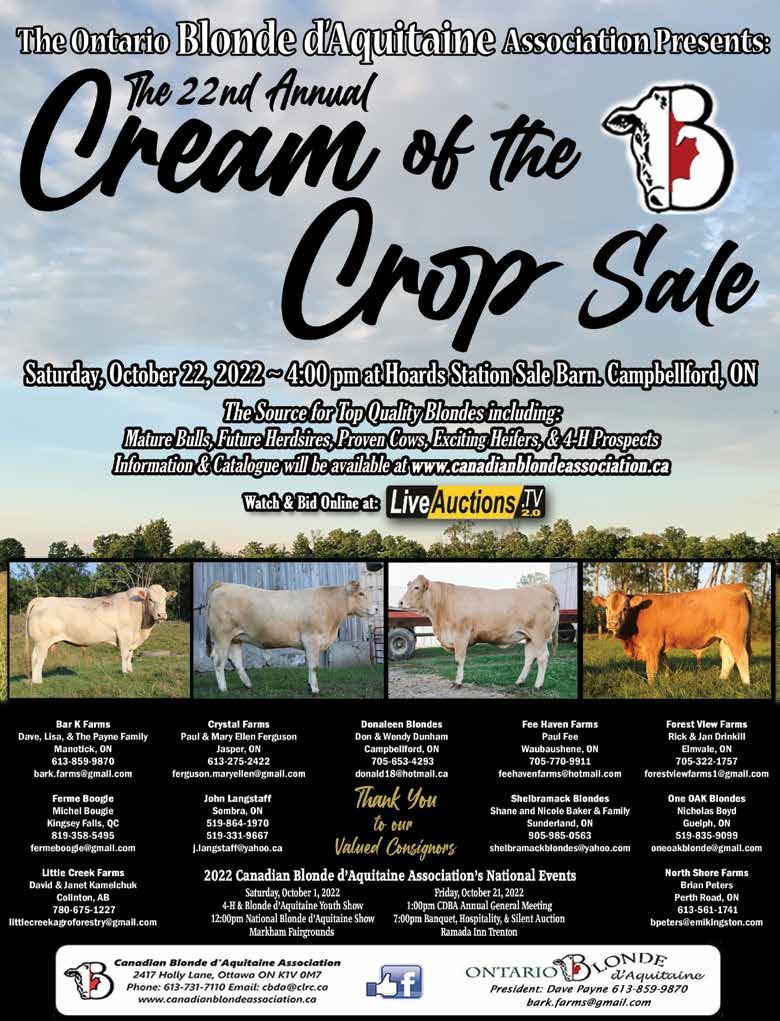
Asked Questions: Livestock Transportation and the Transfer of Care
Q5 As a farmer, what record do I need when transporting my cattle to another one of my properties using a commercial transporter?
Because the cattle are moving from farm to farm, transfer of care documentation is not required. However, an animal transport record would be needed under this scenario.
Q6 Where can I find examples of the transfer of care and animal transport documents?
An Animal Transport Record, which includes the required transfer of care documentation as outlined in the regulation, has been developed by BFO. Hard copy booklets, in triplicate form, can be accessed through the BFO office and are available to auction markets, producers and transporters, free of charge.
Q7 Do I need to use BFO’s Animal Transport Record form when transporting animals in Ontario?
No, transporters can write the required information in any way that works for them. Both the animal transport record and the transfer of care record can be hand written, an email or recorded electronically as long as it is readable and contains the required information, and is retrievable should you ever be asked for it by an inspector. BFO’s Animal Transport Record is simply a tool available to those who wish to use it.
Q8 When did the regulations come into effect?
The humane transport regulations have been in place since 1977, and were updated to improve the well-being of animals during the entire transport process, keeping in mind Canada’s geographic size and the time required to travel between locations. The amended regulations have been in place since February, 2020, but the CFIA focused its enforcement efforts on compliance through promotion, education, and awareness measures. As of February, 2022 CFIA has started to enforce the regulations.
Q9 Will CFIA be performing inspections only at federally regulated plants or will they also be performing inspections at provincial abattoirs and auction facilities?
All modes of transporting animals are regulated: aircraft, carriage, motor vehicle, trailer, railway car, vessel, crate, cargo container, cage, module and/or any other conveyance or container used to move
Processor Links
animals. The Humane Transport regulations are applicable at federal abattoirs, provincial abattoirs, assembly yards, auction marts, etc. Any movement of animals fall under the regulations, CFIA staff is able to do inspections of any of these places at any time.
Q10 What are the requirements for a contingency plan?
A contingency plan is to establish measures to reduce or mitigate avoidable suffering if: there are any unforeseen delays or circumstances that could cause avoidable suffering, injury, or death; or if an animal becomes compromised or unfit during loading, confinement, transport or unloading. There is no prescribed format for a contingency plan (can be written or verbal). However, regulated parties must be able to demonstrate that they know what to do in a variety of predictable, possible, transport situations and any contact information must be up to date.
Q11 How can I complete a transfer when dropping off at a site after hours? Will sending an electronic message (i.e., text message or email) suffice to confirm the transfer of care?
It is the responsibility of regulated parties to make sure they are following the transfer of care process. The provision of the transfer of care notice and document may be done electronically as it does not require the receiver to be present. While it is best practice for the receiver to be present and acknowledged by the consignee, the regulation was written this way to offer flexibility in situations such as these.
Q12 What if an abattoir, assembly yard or auction market refuse to accept the transfer of care?
It is the transporter’s responsibility to make the receiver aware when their role stops, and the receiver’s role starts for the responsibility for care of the animals. While transporters can’t make receivers accept the responsibility, they can make a record of the interaction to protect themselves in the case of a dispute.
Q13 How long should I keep the livestock transport documentation?
It is recommended that all parties should keep a copy of all livestock transport documentation for two years. OB
Connecting Farmers To Processing Space
As a farmer, do you find it difficult to book processing space? Do you want to contribute to an online tool that can make it easier to find available processors offering the services you need when you need them? As a meat processor, do you find yourself spending a lot of time booking processing time with your clients? Do you want to participate and contribute to a solution that helps you and your clients schedule and receive reminders to efficiently use the skilled labour to process animals?
Meat & Poultry Ontario (MPO) together with AgSights have established a dashboard with availability across the province. Together, with abattoirs and farmers they are working to implement a centralized online booking system for Ontario abattoirs called Processor Links. This system enables farmers to book appointments online for livestock processing, which will improve booking visibility, accessibility, and reduce manual administrative tasks.
MPO and AgSights are currently looking to speak with producers who have recently had or are currently having difficulty finding processing appointments. They will be able to provide administrative support to match them with an abattoir that aligns with their processing needs, while also gathering information for a long-term solution to this industry-wide challenge.
If you are interested in this program, please email processorlinks@ agsights.com or complete an intake form (agsights.com/what-isprocessor-links/), which can be found at the bottom of the webpage.
As a reminder, if you take advantage of this program and are matched with a processor who you haven’t worked with before, be sure to discuss your end-product and packaging expectations to ensure you are both happy with the experience. OB
26 ONTARIO BEEF • OCTOBER 2022
Continued from page 24. – Frequently
Emergency Preparedness: A Spotlight on FMD
Compiled by BFO staff with information courtesy of CFIA, OMAFRA and verifiedbeef.ca



If detected in Canada, not only would an outbreak of foot and mouth disease (FMD) severely impact the health of animals, it would lead to an immediate international border closure for beef, pork and dairy exports resulting in a significant and devastating market disruption for several years.

FMD is severe and a highly contagious disease of swine and cattle. It is one of the most contagious animal diseases also affecting pigs, sheep, goats, deer and other cloven (split) hoofed animals, and causes severe production losses in domestic livestock. Human cases of FMD are extremely rare, generally mild and most often associated with consuming infected milk or having direct contact with FMD blisters. It’s also not related to a disease in humans caused by the Coxsackie virus called Hand, Foot and Mouth disease.
If an outbreak did occur, the virus could spread quickly to all parts of the country. Wildlife such as deer, elk and bison could become infected and remain a reservoir for the virus. As such, FMD is a reportable disease under the Health of Animals Act, which means any suspect case must be immediately reported to CFIA. If a positive case is confirmed, specific measures are in place to control and eliminate the disease.
The FMD virus can be spread by people, animals and other objects such as clothing, vehicles, equipment, feed or water. It can also spread through the air-up to 60 km across land and up to 300 km across water. This makes it necessary for Canadians to be extremely alert and take steps to keep the virus out of the country.
Fortunately, Canada has been free of FMD since 1952. The federal government continues to focus on prevention of the disease from entering the country, and the provincial government continues to work with livestock industry organizations, such as BFO, to promote awareness and adoption of sound biosecurity practices, and vigilance for signs of illness and disease at the farm level.
According to the World Organisation for Animal Health, FMD is endemic in several parts of Asia and in most of Africa and the Middle East. In Latin America, the majority of countries apply zoning and are recognized as FMD-free, either with or without vaccination. Australia, New Zealand, Indonesia, Central and North America, and continental Western Europe are currently free of FMD. However, FMD is a transboundary animal disease that can occur sporadically in any typically free area.
The Canadian beef industry continues to advocate for the establishment of an FMD vaccine bank in Canada to ensure we are prepared to respond effectively if an outbreak were to occur in the country. Interestingly, routine FMD vaccination is not allowed in Canada for several reasons. Primarily, routine blood tests cannot distinguish vaccinated animals from infected ones, making vaccinated livestock ineligible for export
with Canada’s trading partners. If Canada did widely vaccinate, we would lose “FMD-free without vaccination” status. Many of Canada’s trading partners, including the U.S., restrict imports from countries that vaccinate for FMD, even for animals that are proven to not carry the virus.
To further understand the characteristics of the disease, it’s important to understand how an outbreak can occur and ultimately spread:
• People, animals, vehicles and other objects that have been contaminated by the virus pass the virus to susceptible animals.
• Meat, dairy products or other animal products infected with the virus are fed to susceptible animals.
• Susceptible animals are exposed to contaminated materials such as hay, feed, water, semen or biologics.
• Animals carrying the virus are introduced to susceptible herds.
• Contaminated facilities (e.g., buildings and pens) and vehicles are used to hold and move susceptible animals.

ONTARIO BEEF • OCTOBER 2022 27
Beef Day @ Guelph Visit www ontariobeef com to register! Saturday, November 26th, 2022 Join us to learn about the latest research, take part in carcass type and meat cut sessions, and hear from speakers while touring new barns at the Ontario Beef Research Centre.
Continued on page 28.
There are ways to help to prevent FMD from entering Canada, specifically around travel precautions and onfarm biosecurity practices.
If you travel:
• Follow all the precautions and routines that Canada Customs and Revenue Agency and CFIA have at airports and other entry points into Canada.
• Do not visit farms in any countries that have had recent outbreaks of FMD.

• However, if returning from a country with FMD, avoid farms, parks, zoos, feed mills, equipment, and livestock for 14 days. If you live on a farm, avoid going home for 36 hours by staying at an alternative residence where someone can bring you clean clothing and footwear to wear home.
• Do not bring back any meat, dairy or other animal products (including hides or skins) even if cured or processed. The virus can survive in these products for an extended period. Meat, dairy products or animal products that have the virus are sources of infection.
• If you visited a farm while abroad, make sure the clothes you wore during your visit are thoroughly cleaned. CFIA recommends dry cleaning of clothes. Also make sure the footwear you wore during your visit is thoroughly cleaned and disinfected. CFIA recommends Virkon® to disinfect cleaned items.
If you have visitors (international and domestic):
• Prevent visitors from having contact with livestock, equipment, feed and water.
• Prevent visits by anyone who, in the last 14 days, has been in any country that had a recent outbreak of the disease. Although people are not susceptible to foot-and-mouth disease, they can be carriers of the virus.
• Have visitors wash and disinfect all personal effects and objects they bring with them. CFIA recommends dry cleaning of clothes.
• It is especially important to thoroughly clean and disinfect footwear. CFIA recommends Virkon® to disinfect cleaned items. Virkon® powder in 2 per cent solution should be used as follows: 20 grams of Virkon® per litre of water. Contact should be for 10 minutes.
If an animal shows signs or symptoms that are similar to FMD, isolate the sick animal and call your veterinarian. Blisters or “vesicles” are the most apparent clinical signs of FMD. The blisters occur on the nose, tongue, lips, between toes, above hooves and on teats. Foot lesions can cause lameness. Other signs include fever, depression, loss of appetite or marked loss of milk production. FMD can be confused with several other animal illnesses, but it’s important to consult a veterinarian if in doubt.
While you wait for consultation with your veterinarian, avoid contact with other farmers. Also ensure everyone on the farm who has had contact with the sick animal also avoids contact with other farmers, and do not allow people, vehicles or equipment to enter or leave your property until the animal has been assessed.
Emergency preparedness, implementation of important on-farm biosecurity measures, travel and visitor precautions, and education will all contribute to our sector’s ability to avoid or minimize the impact of a major FMD outbreak. Being as prepared as we can be will be our first line of defense. OB
28 ONTARIO BEEF • OCTOBER 2022
Continued
from page 27. – Emergency
Preparedness: A Spotlight on FMD
CCA


CCA Celebrates the Return of their BBQ on the Hill
Submitted by CCA Staff www.cattle.ca
Fall’s arrival often represents a fresh start for many with a return to regular routines with back to school, harvest, and preparations for the fall cattle run. It also sees the return of our elected officials to Ottawa and the much-anticipated Canadian Cattle Association’s (CCA) annual BBQ on the Hill to help kick-off the fall session of Parliament. This BBQ-style reception on the Hill provided a friendly atmosphere for CCA directors and staff to reconnect with Parliamentarians and their staff and informally discuss the policy priorities of cattle producers in the lead up to the consultation for the next federal budget. It was great to have so many of our Parliamentary colleagues, new and old, join us for a delicious and nutritious burger made from certified sustainable beef - a fitting touch following our successful “Don’t Label My Beef” campaign earlier this year.
To wrap up the first week of the Fall session, Environment and Climate Change Canada (ECCC) released Faster and Further: Canada’s Methane Strategy on September 23, 2022. The Strategy outlines the Government of Canada’s plan to reduce domestic methane emissions by more than 35 per cent by 2030, compared to 2020 levels. Notably, the agriculture sector is expected to reduce methane emissions by 1 per cent from 2020 levels—an expectation previously announced in the Government of Canada’s Emissions Reduction Plan.
reason, it is important that Canada is not reliant on the U.S. and have an in-house vaccine bank. The Canadian Food Inspection Agency agrees with us on this point, but the challenge remains securing the funding needed to support establishing and maintaining the doses. CCA will continue to build on our advocacy efforts on this issue and this will be a key ask in our submission for pre-budget consultations.
Everyone has a role to play in stopping the spread of FMD. When returning from an FMD positive country, please report this to the Canadian Border Services Agency and avoid contact with livestock or agricultural operations for at least five days, and 14 days if you have been in rural areas or in close contact with livestock. It is also recommended that footwear should be left behind if you know you’ve been in a country that’s positive.
Sustainable CAP and BRM


We will continue to engage the federal government on the rollout of the Canadian Agricultural Partnership (Sustainable CAP). We are awaiting to hear details on the consultation process that will take

UPDATE
Our consignments: ANGUS x HEREFORD Bred Hereford - Due in March Jamie, Mel & Blake O’Shea Denfield, ON 519-477-1238 osheafarms@hotmail.com Top Cut Commercial Visitors always welcome to come select your next herd bull.
Continued
on page 30.
place with industry on the review of AgriStability and how it can be improved to make it faster, simpler, and more predictable for the benefit of all cattle producers across Canada.
An environmental objective has also been added to business risk management (BRM) programming, specifically there is now an environmental cross-compliance component for larger farms wanting to participate in the AgriInvest program. In addition, further avenues will be explored to integrate climate risk and readiness into BRM programs. We are concerned this may make an already complex suite of programs even more complicated, which conflicts with the goal of simplifying AgriStability. We will continue to share our concerns with the federal government.
Forage Insurance
CCA is also encouraging the development of improved forage insurance products for pasture and hay. In 2022, forage samples were collected in Ontario as part of a national, CCA-sponsored project aimed at measuring forage production using satellite imagery. The project outcomes will be considered by an Industry-Government Forage Insurance Task Team that will begin meeting in the fall. The team includes representation from the Ontario Ministry of Agriculture, Food and Rural Affairs.
The International Stage
Policy conversations happening on the global stage often feel far removed from what’s happening day-to-day on Canadian cattle ranches and farms, but experience has shown us that these conservations foreshadow domestic regulations to come. As an example, 30 years ago at the Earth Summit hosted by the United Nations (UN) in Rio de Janeiro, spoke to the urgency of climate change. Now, climate change regulations are a key consideration at all levels of government, and this is a very active file for us. CCA representatives
from the Board and staff are participating in key international fora throughout the fall, notably:
• The Private Sector
Mechanism in early October, hosted in Rome, Italy, where two youth leaders will take part in the UN Committee on Food Security.
• The Global Agenda for Sustainable Livestock (GASL) 12th MultiStakeholder Partnership Meeting in Dublin, Ireland in early October.
• Conference of the Parties of the UNFCCC (COP 27) on climate change solutions in Egypt in November.
CCA’s BBQ on the Hill was co-hosted by Senator Rob Black (centre) who was joined in this photo by Canadian Cattle Young Leaders representatives Charlene Yungblut (right) and Victor Drury (left).
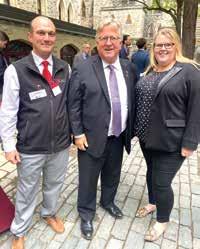
• Conference of the Parties (COP15) to the UN CBB (COP 15) on biodiversity, hosted by China in Montreal in early December.
We are proud of the role that cattle production plays in climate change and working landscapes, as well as nutritional benefits of eating beef. We will share this story to ensure that an accurate perspective of sustainable beef production in Canada are shared and considered in these important policy discussions.
CCA will at the table representing your interests in Ottawa and internationally to ensure the best outcome possible for beef producers across Canada. OB
Nominate a Deserving Producer for The Environmental Stewardship Award
 By Bethany Storey, BFO Communications Specialist
By Bethany Storey, BFO Communications Specialist
Ontario beef is not only produced sustainably, it also has a positive impact on our environment. This dedication to our land and the future of our farms needs to be highlighted and shared, not only within our industry but to our consumers and the public.
Since 1996, The Environmental Stewardship Award (TESA) has been awarded annually at the provincial and national level to recognize beef farmers’ leadership in conservation. Nominees and applicants are selected based on their stewardship practices, accomplishments and goals.
Producers can either be nominated by an individual or organization, or apply themselves. Both methods are equally encouraged. The national TESA recipient is announced during the Canadian Beef Industry Conference (CBIC) awards’ banquet. All provincial recipients are awarded an all-expense paid trip for two to attend CBIC that is held in different locations across Canada in August of each year.
The Ontario recipient of The Environmental Stewardship Award will be recognized at the Beef Farmers of Ontario (BFO) Annual General Meeting (AGM), as well as provided the option to offer a presentation at the AGM or a webinar in the spring. Further benefits for Ontario TESA recipients include:
• Recipient’s farm will be highlighted in an Ontario Beef video showcasing their environmental work, and its importance to sustainability and stewardship.
• Recipient will receive a $2,000 cash award, and also direct a $500 donation to a BFO-approved conservancy or environmental group of their choice.
• A choice between a farm sign or plaque, recognizing them as the Ontario TESA recipient.
BFO encourages individuals or organizations to nominate a beef farmer/farm who they feel is deserving of recognition for their environmental efforts. An Ontario TESA Nomination Form is available to submit to BFO staff who will work with the nominee to complete their application. BFO equally encourages beef farmers/farms to nominate themselves for this award through submitting the official TESA application form.
The deadline for the 2023 Ontario TESA application/nomination is November 30th, 2022.
Nomination and application forms can be found at www.ontariobeef.com, or by contacting Beth Storey at the BFO office by email at bethany@ontariobeef.com.
30 ONTARIO BEEF • OCTOBER 2022
Continued from page 29. – CCA Update
OB
Cow-Calf Management Tour Visits Simcoe County
 By Jaclyn Horenberg, BFO Senior Producer Relations Specialist
By Jaclyn Horenberg, BFO Senior Producer Relations Specialist
The Cow-Calf Management Tour took to the rolling hills of beautiful Simcoe County to visit progressive beef farms on August 26th and 27th. With over 45 registrants, and 10 sponsors representatives, we had a great group for networking.
The event kicked off with a tour of Doug and Cal Shelswell’s 170-head cow-calf-to-finish operation. The family works together to manage the cattle and the 950 acres that they crop. Cal talked about the management of the cow herd, which consists of mostly crossbred cows. Doug discussed the importance of getting involved in organizations and taking advantage of programs while they are available. They are audited with the Verified Beef Production Plus program as well as the Ontario Corn Fed Beef Program. This hard-working family ensures that everyone has a role in helping to contribute to the success of the farm.
Our next stop was just up the road to the home of Michaela and Chris Stoneman, which is the summer pasture and show cattle area for JPD Angus. Michaela’s parents, Lori and Darryl Chalmers, started JPD Angus in 2009 when they took the farm over from Lori’s parents. They currently calve around 60 purebred black Angus cows. Michaela spoke about the strong emphasis that they put on breeding for cow families with an aim to build strong maternal lines that their customers can bank on. Michaela’s brothers are also involved in the farm, so when asked about who the boss is, Michaela replied that the team is the boss, and if someone isn’t pulling their weight, the team makes sure that they do. As the Ontario Beef Youth Alliance (OBYA) representative to the BFO Cow-Calf Committee, it is great to see the passion that Michaela has for the beef industry.
We then made our way to the Allure Hotel in Barrie where we enjoyed a local Ontario beef dinner. We were joined by Barb Caswell from the Ontario Soil and Crop Improvement Association (OSCIA) to discuss the success of the first intake period of the On-Farm Climate Action Fund (OFCAF). The Cow-Calf Management Tour was an approved knowledge sharing event (KSE) for the OFCAF program. Next, we had Birgit Martin, one of the grazing mentors with the
Barb Caswell from the Ontario Soil and Crop Improvement Association discussed the success of the first intake period of the On-Farm Climate Action Fund. The Cow-Calf Management Tour was an approved knowledge sharing event (KSE) for the OFCAF program.

Canadian Forage and Grassland Association, join us to talk about her experience with managing pastures through the growing season. Birgit farms with her husband, Jim, and their two sons, Alex and Nick, on Manitoulin Island where they operate a cow-calf-to-finish farm and custom grazing operation. Birgit is passionate about pasture management and was able to share many practical tips for producers to continue discussing during the evening hospitality.
The tour continued the next morning at the farm of Jim and Myrna Whitley on the beautiful Niagara Escarpment area. With a five-year business plan, Jim and Myrna, increased their cow herd to 50 quality Charolais cows, expanded their rotational grazing setup, and worked with one of their sons to develop a grass-fed direct beef marketing business. Jim shared the importance of putting family first, and the value in taking the time to ensure you are still enjoying what you are doing. After having to chase the cows out of the corn field earlier that morning before we showed up for
Continued on page 36.
With a five-year business plan, Jim and Myrna Whitley, increased their cow herd to 50 quality Charolais cows, expanded their rotational grazing setup, and worked with one of their sons to develop a grass-fed direct beef marketing business.

ONTARIO BEEF • OCTOBER 2022 31
Michaela and Chris Stoneman hosted the group on their farm which is the summer pasture and show cattle area for JPD Angus.
CANADA BEEF UPDATE Team Canada Competes at 2022 World Butchers’ Challenge

 By Gina Teel, Manager, Stakeholder Communications, Canada Beef
By Gina Teel, Manager, Stakeholder Communications, Canada Beef
Canada Beef will launch the Canadian Beef Information Gateway (Gateway) in 38 Ontario outlets of Loblaw Companies Ltd. Real Canadian Superstore this fall.
This first partnership with a national retail banner arrives within the Gateway’s debut year. A second part to the launch is slated to follow in Real Canadian Superstore outlets in Western Canada.

This national launch is a significant development for the Gateway, which introduced the first phase, Canadian Beef edition for smaller retailers and those looking for easy to implement solutions in January 2022.
To maintain traction, Canada Beef hired Kelly Hyde as Director, Canadian Beef Information Gateway, in July. This new, dedicated role is designed to ensure the Gateway delivers on the promise we see for this initiative.
The Gateway is among Canada Beef’s most important initiatives to date and has the potential to share a broad range of consumer-friendly beef information in a digital format that aligns with current consumer behaviour and preferences for information.
The results for the latest Cooking by Degrees digital and social media campaign are in and by all accounts the numbers suggest a resounding success. The 2022 campaign highlighted some of Canada’s best college and university chefs and their favorite Canadian beef recipes along with a wide variety of sustainability perspectives and stories of Canada’s beef farmers and ranchers.
The campaign is the result of a collaboration between Canada Beef, Canadian Cattle Association’s Public and Stakeholder Engagement (PSE) team and the Canadian Roundtable for Sustainable Beef (CRSB), in partnership with the Canadian College and University Food Service Association, and the Star Metroland group of digital and print publications.
The Cooking by Degrees campaign ran from mid-June to mid-August 2022. The timing of the campaign was fortuitous given the chefs had selected ground beef as their preferred cut. Thus, numerous articles and recipes from chefs that showcased ground beef as a versatile, nutritious and delicious cut ran on Star Metroland platforms about the same time that ground beef was in the news around front-of-package labelling.
The campaign results indicated the audience was interested in the content provided, as page view deliveries, and click-through rates for the surrounding sponsored ads - which link people to Canada Beef, PSE and CRSB URLs for more information - met or exceeded industry averages. The main key performance indicator of time spent reading the articles exceeded the average for the Toronto Star on all articles, an average of 1.5 times across all articles. Engagement rates were strong on accompanying sponsored social posts, and the campaign delivered more than 3.2 million impressions overall.
The top overall performing article was Chef wants students to raise their own beef, featuring Anne Wasko, former chair of the CRSB. The article
entitled Ukraine specialty one of the most popular homegrown meals, with beef producer Duane Thompson and family of Saskatchewan, and their “The only factory on this farm eats grass” story had the most page views. The top performing article for time spent was Two out of three ain’t bad when making this meatloaf.
As a package, the campaign served as a resource for those looking for a diverse range of recipe ideas, and insight into the dedication of Canadian beef farmers and ranchers. The series’ longevity is significant: the articles continue to live on the Star’s site as evergreen content.
Canada Beef’s latest video takes a short and lively look at beef’s role as a meal maker and its often-untold nutrition story. Discover Beef’s Nutrition Story was created in August 2022 to support beef nutrition information and messaging. The goal was to create a broad, foundational video about beef’s remarkable nutrition story in an engaging and easy to follow format for consumers. Check out the video on Canada Beef’s website and on our YouTube page.
In September, Canada Beef participated in the prestigious 2022 World Butchers’ Challenge (WBC) in Sacramento, California. Canada Beef President Michael Young was among the international judges selected to preside over the so-called Olympics of Meat.
The WBC main event saw a record 13 teams from around the globe participate. This included first-time participant Team Canada, led by captain Peter Baarda, three-time winner of Ontario’s Finest Butcher competition and owner of J & G Quality Meats. Ontario butchers comprised more than half the team, and included Brent Herrington of Herrington’s Quality Butchers, Damian Goriup of Florence Meats, and Dave Vander Velde of VG Meats. Taryn Barker (B.C.), Corey Meyer (AB), and Elyse Chatterton (AB) rounded out the team.
The event also included the World Champion Butcher Apprentice and Young Butcher competitions.
Germany took top honours at the WBC competition, followed by Australia in second spot and New Zealand in third place. The World Champion Butcher Apprentice and Young Butcher competitions were won by teams from Australia and France, respectively.
Canada Beef congratulated Team Canada for the tremendous effort put forth in their debut performance at WBC 2022. As a sponsor of Team Canada, Canada Beef is very proud of the team’s hard work and dedication to showcase their skills and the trade of butchery and meat cutting.
Young noted the competition was fierce for the top spots on the podium. “It was a great experience for Canada to compete on the world stage. Team Canada did an excellent job and we look forward to seeing them back at the World Butchers’ Challenge in 2024.”
The 2022 Canada Beef Global Stakeholder Satisfaction Survey produced an overall satisfaction score of 75 per cent, an improvement over the previous year’s survey. The feedback from survey respondents ensures meaningful improvements will continue to be made to Canada Beef’s programs, services and activities as we strive to increase satisfaction levels for all stakeholders. OB
32 ONTARIO BEEF • OCTOBER 2022
International judges of the 2022 World Butchers’ Challenge
Team Canada
FOCUS ON HERD HEALTH
 By Jacques Van Zyl, DVM, Metzger Veterinary Services
By Jacques Van Zyl, DVM, Metzger Veterinary Services
Pinkeye in Cattle
Eye problems are common in cattle, particularly during the summer months. The most significant eye disease in cattle is called Infectious Bovine Keratoconjunctivitis (IBK), or more commonly known as pinkeye.
For the purpose of this article, when I am referring to pinkeye, I am referring to IBK, which is defined as a herd level disease affecting only the eyes. A large proportion of the herd may be affected, and the disease is characterized by rapid spread between animals with symptoms such as inflamed conjunctiva (conjunctivitis), runny eyes (epiphora), squinting (blepharitis), inflammation of the cornea (keratitis), cloudiness of the cornea (corneal opacity) and/or a physical defect of the cornea (ulceration).
Diseases that affect the eye often look alike. As a result, the term pinkeye is often incorrectly applied to many different ocular diseases in cattle. If you notice that your cattle have runny or sore eyes, this does not necessarily mean they have pinkeye. Other diseases that lead to runny or cloudy eyes include Infectious Bovine Rhinotracheitis (IBR), Malignant Catarrhal Fever (MCF) or Bovine Viral Diarrhea (BVD). These diseases have clinical signs that impact the entire body such as fever, diarrhea, or dull demeanours. Other, more mild infections of the eye can simply cause runny eyes or squinting. Care must be taken to correctly identify which disease is impacting your herd so that you can treat appropriately. The overlap of clinical signs that we see between ocular diseases plays into the difficulty of appropriately diagnosing pinkeye, and also in determining how prevalent this disease truly is.
Pinkeye is known to be caused by a bacteria called Moraxella bovis. It is important to note that there are many other bacteria that have also been associated with pinkeye infections in cattle. These include Moraxella bovoculi, Mycoplasma bovis, and Mycoplasma bovoculi. While none of these other bacteria have strong support as a direct cause of pinkeye, they may predispose animals to the infection and can even act in synergy with Moraxella bovis to worsen the disease.
Pinkeye usually starts as clear discharge from one or both eyes that can become purulent (yellow). As the infection progresses, the centre of the eye becomes cloudy as fluid leaks into the cornea. The cornea then turns to a yellow color and can develop a red rim before developing an ulcer or even rupturing. Luckily, cattle have a remarkable ability to repair their eyes. If we can initiate treatment, the eye can heal in one to three weeks, with the average herd outbreak lasting approximately 30 days.
Much like the bacteria that cause shipping fever in cattle, Moraxella bovis and Mycoplasma bovoculi can be found on the eyes of healthy cattle. Under normal conditions, the eye typically resists infection by washing away any bacteria with tears, which contain

antibodies to fight infection. For infection to occur, there generally needs to be other predisposing factors. These can either be in the form of another infectious agent like the bacteria listed above, or they can be environmental factors. The more common environmental factors include, but are not limited to, face flies, UV light or damage from plants, pollens, or dust.
Face flies are commonly thought to be a leading contributor to pinkeye. As their name implies, they spend most of their time around the face as they feed on bodily fluids including tears. When they land on the eye, there is direct damage to the surface due to rasping of their teeth. Moraxella bovis live in the gut of these flies and they regurgitate the bacteria onto the eye. This allows the bacteria to get a good hold in damaged sections of the eye and can lead to infection. When cattle have a pinkeye infection, the flies tend to spend more time on affected eyes, which can contribute to the spread throughout the herd. Face flies are more active at temperatures between 25-29°C and fly populations generally peak between late June and early August in North America. This coincides with the period in which pinkeye tends to be the most prevalent.
Other environmental factors that impact susceptibility to the disease include UV light and mechanical irritation. UV light damages the cells that make up the outer layer of the eye. When damaged, these cells become what are known as ‘dark cells’. Moraxella bovis
ONTARIO BEEF • OCTOBER 2022 33
Continued on page 34.
selectively attaches to these dark cells, so if an eye contains more dark cells, it is more likely the bacteria will be able to grab hold and cause an infection. Lastly, anything that causes direct damage to the eye will allow the bacteria to colonize and predispose to infection. This includes dust, pollens, and grass awns.
If you notice an outbreak of pinkeye in your cattle, treatment should be initiated immediately. Conditions that cause pinkeye in one animal are likely to be affecting others in the herd. Pinkeye is a painful condition in cattle, and treatment has been shown to improve healing times and reduce the risk of poor outcomes. When determining what to treat with, a major consideration should be which antibiotics are best able to reach the site of infection. In Canada, Oxytetracycline, Florfenicol and Tulathromycin are labelled for the treatment of pinkeye. Supplementary care such as antiinflammatories may also be warranted. Some producers opt to cover the eye with a patch to keep flies and debris out during the healing stage, and some veterinarians have even stitched the eye closed for the same reason. Many times, these outbreaks occur when cattle are on pasture and individual treatment of animals is unfeasible. Consult with your veterinarian as to which antibiotic is most appropriate, and to determine if there are other formulation options available to suit your needs.
Prevention should be focused on minimizing the contributing factors. As previously mentioned, Moraxella bovis can be found on healthy eyes, so eliminating the bacteria itself from cattle is unfeasible. Efforts are typically directed towards fly control as the
amount of pinkeye in a herd has been observed to decrease after fly control products are applied. Pyrethroid insecticides are generally used, and there does not seem to be a difference in efficacy between ear tag or pour-on formulations. Nonchemical measures such as harrowing fields to break up cow patties or appropriate rotations can also be implemented to reduce fly numbers and help prolong the usefulness of chemical products. Providing shaded areas to decrease UV light and mowing pastures before the grass is headed out can also decrease mechanical irritation to the eye.
Vaccination has also been looked at for prevention of pinkeye. There are a few injectable vaccines on the market, but evidence that they protect against pinkeye is variable. Autogenous vaccines are specifically made from bacterial strains isolated from affected animals and intended to be used in the herd where the diseased animal originated. These vaccines are made in licensed facilities and intended to be used when a commercial product is unavailable or not effective. Consistent and reliable information on the efficacy of autogenous vaccines is lacking. Currently there are no intranasal or aerosolized vaccines on the market.
Pinkeye outbreaks can be frustrating for producers due to the difficulty of accessing cattle on pasture. Care must be taken to ensure appropriate diagnosis so treatment can be initiated. If you are experiencing pinkeye in your cattle, talk to your veterinarian to discuss treatment options. This may also be a great time to discuss preventative measures for future years. OB
!CHECK-OFF DEDUCTION REMITTANCE FORM
Every cattle seller (including sales by private treaty) is required under Regulation 54 of the Beef Cattle Marketing Act (BCMA) to pay a $4.50 per head Ontario license fee and a $1.00 per head national levy, for a total of a $5.50 per head check-off. Breeding stock, cull dairy cows, and beef calves are included. Exemptions exist only for cattle sold for the production of milk and veal. Fees are payable by the 15th of the month following deduction. Please note: Licenced Livestock Dealers who sell cattle within seven business days of having purchased them may apply for a rebate with proper documentation.
Firm or Individual Producer Reporting
HST Registration No:
Period Covered by this Report:
a) Number of Head Sold: Finished: Stocker: Breeding Stock Females: Culls: Breeding Stock Bulls: Calves:
b) Total BFO Check-off ($5.50xa)
c) HST on BFO Check-off (bx13%)
d) Total Amount Owing (b+c)
Mail to:
Beef Farmers of Ontario 130 Malcolm Road Guelph, Ontario N1K 1B1
Forward cheque payable to the Beef Farmers of Ontario with this report. Please retain one copy for your files.
I declare that this information represents a true and accurate statement of check-off deductions required to be made under Regulation 54 of the BCMA and the Canadian Beef Cattle Research Market Development and Promotion Agency.
Date:
Signature:
Print Name: Address:
34 ONTARIO BEEF • OCTOBER 2022
HST# R107797128
Continued from page 33. – Focus on Herd Health
MARKET INFORMATION UPDATE
By Jamie Gamble, BFO Market Information Coordinator markets@ontariobeef.com • www.ontariobeef.com

Statistics Canada released their Cattle Statistics Report in August 2022 reporting steers one year and older on Ontario farms at 296,800 head. Comparing July 1st to July 1st volumes, 2022 is just slightly lower than July 1, 2021 but larger than 2019 and 2020 by 4 per cent and 3.1 per cent respectively. Looking at fed heifers on Ontario farms, Statistics Canada reported 120,900 head on July 1, 2022. The January 1, 2022 volume of fed heifers was at 117,600 head, which was the lowest on-farm volume in Ontario since January 2000. The July 1, 2022 volume of fed heifers is up 2.8 per cent from January 1, 2021, but comparing just July 1st numbers, it is the lowest fed heifer volume since data collection began in 1972. The total volume of fed cattle on Ontario farms on July 1, 2022 is 417,700 head, down 1.3 per cent from July 2021 but up 1.6 per cent from 2020 and 1.3 per cent more than July 1, 2019.
The replacement beef heifer volume on Ontario farms on July 1, 2022 was 37,500, up 8.7 per cent from January 1, 2022. Comparing July 1st volumes, 2022 is up 2.5 per cent from 2021, down 5.8 per cent from July 1, 2020 and 8.5 per cent below 2019. Volumes of replacement beef heifers since January 1, 2021 have been the lowest since data collection began in 1972. The beef cow volume on Ontario farms was 231,200 head on July 1, 2022, up 6.2 per cent from January 1, 2022 and 3 per cent above last July, but the third lowest volume since the 1950’s. Dairy cow volumes on Ontario farms are at 324,300 head on July 1, 2022, down 200 head from January 1, 2022. For the last five years, dairy cow volumes have seen limited change with numbers anywhere from 319,100 to 327,300, with 2022 volumes right in the middle of the range. Replacement cattle volumes on Ontario farms as of July 1, 2022 total 415,700 head, down 1.3 per cent from July 1, 2021 but 1.5 per cent above July 1, 2020 and steady to July 1, 2019.
Please note that September 2022 values are calculated from Sept 1-19th due to print deadlines. The Ontario fed cattle market has been strong this year following a solid second half of 2021. Railgrade prices started out at $290.00 dressed for the first third of 2022. April until June prices peaked at $320.00 dressed for three weeks and have slowly declined into the early fall. At time of reporting (mid-September), the market is around $303.00 dressed which is a five per cent decline from the spring high, but still the strongest prices seen since 2015. Typically, the fed prices decline from August into September and this year is no different. Since 2001, there have only been five years where the prices increased from August into September and four of those were during BSE and three years directly afterwards, and 2021 during the COVID-19 pandemic. For pretty much all of 2022, Ontario fed cattle have been selling at prices stronger than Alberta and the U.S., however at time of reporting all three areas are trading at about par.
Federal processing volumes in Ontario as of September 17th total 433,426 head, down 0.9 per cent from the same time in 2021, but up 4.6 per cent from the same time in 2020. Provincial processing
volumes in Ontario as of August 31st are at 59,698 head, down 0.8 per cent from the same time in 2021 and the second largest volume in this data set. Combined, the volumes of steers processed are down 2.1 per cent from last year at this time, heifer volumes are 21 per cent lower and cows up 3.7 per cent over this time last year. Bull volumes are low, but it is important to note that all volumes are preliminary for 2022. Carcass weights this year have been lower than last year until August where steer weights have increased above last year and the five-year average. Light volumes, strong demand and high feed prices for the first half of this year have kept the cattle moving which is evident in the average carcass weights.
The fed/cull cow market has been strong this year with lighter volumes sold. As of August 31, 2022 there has been 74,084 cows sold through auction markets, down 7.3 per cent from the same time in 2021 and 10.5 per cent fewer than 2020. The beef cow volume sold is up 22.5 per cent from the same time in 2021 and 22.9 per cent more than this time in 2020. Dairy cow volumes are down 14.3 per cent from August 31, 2021 and 18 per cent fewer than 2020. Beef cow prices are strong and that paired with high feed costs have brought more beef cows to market. Prices did top out in July and are starting to decline slightly, but well above prices seen since 2015.
The stocker and feeder cattle markets are strong! Monthly average prices are well above last year, 2020 and the five-year average in all weight categories. The lighter weights started the year steady to lower, but since April 2022 prices have taken off. Heavier weights have been stronger all year, but all weight categories have seen prices increase sharply from August into September. Monthly average prices in the majority of stocker classes have not been this strong since early 2016. Volumes sold so far this year are lower than last year, but better pasture conditions in many areas could play a part in the lighter volumes, along with the declining numbers. Prices generally tend to decline after the September/October peak but demand will dictate where prices lay this fall.
The special fall stocker sales have started to commence with the majority of sales taking place in October and November. Vaccinated and pre-conditioned stocker and feeder cattle (i.e. dehorned, castrated etc.) are in high demand and will bring a better price than non-processed cattle. Many of the upcoming fall stocker sales feature vaccinated cattle.
Info-Link cards are available on our website under Services or ask the auction market if they have any available. Info-Link cards are a pen-card that farmers can use to document feeder cattle information on vaccination, parasite control, implants and any other pertinent information. These cards are designed to help facilitate information flow between buyers and sellers of feeder cattle. Info-Link cards are to be submitted to sales barn staff when selling feeder cattle. The cards can be placed on the pens holding the cattle or the information can be read by the auctioneer when the cattle enter the sale ring. OB
ONTARIO BEEF • OCTOBER 2022 35
Continued on page 36.
David and Tate Millsap toured attendees through their newest feedlot barn, and talked about the attributes they look for when sourcing calves.

the tour, Jim may have been secondguessing if he still enjoys the cows! Jim’s goal-oriented work ethic lends itself well in his role as a VBP+ auditor, and he says he appreciates the opportunity to tour and learn from other people’s farms.
Christine O’Reilly, Forage and Grazing Specialist with OMAFRA, joined us in the field to talk about pasture rest, recovery and regrowth.
Our final stop of the tour was to see the feedlot side of the industry at David Millsap’s feedlot. David and Corrie, along with their sons, Tate and Jack, finish about 1,500 head of cattle per year and are certified with the Ontario Corn Fed Beef Program and VBP+. They also crop land jointly with David’s neighbouring cousin, John Millsap. David and Tate toured the cow-calf producers through their newest feedlot barn, and talked about the attributes they look for when sourcing calves. They spoke about the value of having a good team of experts to consult with to do a good job feeding cattle. After a delicious smoked brisket lunch at the Millsap home farm, BFO Cow-Calf Committee Chair, Blair Williamson, thanked the family for their hospitality.
On behalf of BFO, we would like to thank all of the participants for making the Cow-Calf Management Tour such fun! The farm hosts were incredibly generous to welcome producers to their farm, and to share their production practices. Thank you to the speakers for sharing their knowledge and expertise. This event would not have been possible without the generosity of the many sponsors who continue to invest in the Ontario beef industry. We sincerely appreciate everyone who helped make this event possible, and we look forward to next year! OB
36 ONTARIO BEEF • OCTOBER 2022
Continued
from page 35. – Market Info
Continued from page 31. – Cow-Calf Management Tour Visits Simcoe County
Continued on page 38.
Changes to OBCFPP Licenced Dealers List
No Longer Licenced
Livestock Dealer
Tebo Livestock Tweed, ON Allan Stirling Little Britain, ON
The entire OBCFPP list can be found on the OMAFRA website at www.omafra.gov.on.ca/english/food/inspection/fpu/fpu_lists.htm
Or for more information: Toll Free: 1-888-466-2372 ext. 64230 Local: (519) 826-4230
E-mail: foodinspection@ontario.ca
ONTARIO BEEF • OCTOBER 2022 37
38 ONTARIO BEEF • OCTOBER 2022 Continued from page 37. – Market Info
BEEF EXPORTS - CANADA
United States Mexico
Jan. 1 - Jul. 31, ‘22 % Change Jan. 1 - Jul. 31 ‘22 % Change
Total 201,894 tonnes +2% 14,334 tonnes +4% Japan China
Jan. 1 - Jul. 31, ‘22 Jan. 1 - Jul. 31, ‘22
Total 44,086 tonnes +34% 12,927 tonnes +142%
BEEF PRODUCTION - CANADA
Jan. 1 - Sept. 10 ‘22 Last Year Same Time % Change
Fed 783,752 tonnes 778,505 tonnes +1%
Non-fed 107,640 tonnes 107,078 tonnes +1%
BEEF IMPORTS - CANADA
Jan. 1 - Sept. 10, ‘22 Last Year Same Time % Change
US 74,206 tonnes 70,465 tonnes +5%
Non-NAFTA 23,293 tonnes 24,983 tonnes -7%
EU-28 (beef/veal total) 9,805 tonnes 9,859 tonnes -1%
Total 116,915 tonnes 114,447 tonnes +2%
LIVE CATTLE - CANADA
IMPORTS
EXPORTS EXPORTS
Jan. 1 - Jul. 31, ‘22 Jan. 1 - Sept. 3, ‘22 % Change
Pure bred 9,469 Slaughter steers & heifers & cows 323,584 +15% Non-Purebred 116,324 Feeder cattle & calves 159,453 +109% Bulls 27,008 +6%
LIVE CATTLE EXPORTS - ONTARIO
Week ending Sept. 3, ‘22 Week ending Aug. 27, ‘22 Year to Date
Total to US. 1,682 1,783 61,896 Steers, Heifers, Cows 1,519 1,640 57,879 Bulls 163 93 4,017
ONTARIO BEEF • OCTOBER 2022 39
CALENDAR Ontario Beef Industry Events
October 21 – Annual Meeting, Canadian Blonde d’Aquitaine Association, Trenton

October 21 – Hereford Stocker Sale, Brussels
October 22 – 22nd Annual Cream of the Crop Blonde d’Aquitaine Sale, Campbellford
October 22 – Walnut Drive Farms Hereford Super Sale, Listowel

October 24– Limousin Influenced Feeder Calf Sale, Listowel
October 28 – Limousin Influenced Feeder Calf Sale, Cargill
October 29 – Simmental Influence Feeder Calf Sale, Keady
November 4-13 – Royal Agricultural Winter Fair, Toronto, Ontario. Visit BFO in the education area.


ROYAL AGRICULTURAL WINTER FAIR - 100TH ANNIVERSARY
Thursday, November 3
• Charolais Players Club Event
• Hereford Futurity
• Angus Futurity
Friday, November 4
• National Charolais Show
• Masterfeeds National Junior Beef Heifer Show - Showmanship
• National Charolais Sale
Saturday, November 5
• National Hereford Show
• Masterfeeds National Junior Beef Heifer Show - Conformation
• National Limousin Show
• The Royal National Angus Sale
hugh.clarkeffi@gmail.com
Sunday, November 6
• National Simmental Show
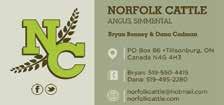
• National Shorthorn Show
Monday, November 7
• Limousin Junior Show
• Hereford Junior Show
National Angus Show
Masterfeeds Beef Supreme Championship
Angus Junior Show
Shorthorn Junior Show
November 8 – Virtual Grazing Cover Crop Workshop, 7-8 p.m. Visit BFO website for more details
November 12 – Top Cut Commercial Bred Heifer Sale, Hanover
November 15 – Virtual Grazing Cover Crop Workshop, 7-8 p.m. Visit BFO website for more details
November 19 – Fall Classic Shorthorn Sale
November 19 – Limousin Influenced Female Sale, Listowel
November 21-22 – OFA Annual General Meeting, RBC Place, London
November 22, 23 & 24 – Forage Focus Webinar Series, 12 p.m. to 1 p.m. Visit ONForageNetwork.ca for details.
November 26 – Beef Day @ Guelph, Research update, carcass quality discussions and facility tour. Visit BFO website for more details.
December 10 – Eastern Showcase Limousin Sale, Hanover
January 12-14 – Beef Industry Convention, Best Western Lamplighter Inn, London, beefindustryconvention.com
January 4-18 – On-Farm Climate Action Fund. Intake opens on January 4th and closes on the 18th.
February 22-23 – BFO Annual General Meeting, Delta Hotel Toronto Airport and Conference Centre
40 ONTARIO BEEF • OCTOBER 2022 Advertise in BEEF BUSINESS LEADERS Very reasonable rates! Deadline for December 2022 issue is November 15. Call 519-763-8833 for information Advertise in BEEF BUSINESS LEADERS Very reasonable rates! Deadline for December 2022 issue is November 15. Call 519-763-8833 for information • Auction Sale Since 1949 • Sale Every Tuesday 12 p.m. • Three Rings – Beef, Dairy, Pigs • Quinte Cattlemen’s Stocker Sales • Spring and Fall Member of O.L.A.M.A R.R #5 Campbellford, Ontario Dave DeNure 705-653-3660 HOARDS STATION SALE BARN Bulls and Heifers FOR SALE. DNA verified for carcass and feed efficiency. Ross & Betty Small & Family R.R.#3 Harriston ON N0G 1Z0 Tel: 519-338-2077 • 1-800-461-3504 • Email: doraleegenetics1@sonicwaves.ca See our new website: www.doraleegenetics.com Quality Proven Fleckvieh Simmental Breeding StockSince 1973 GENETICS BEEF BUSINESS LEADERS Miller Land & Livestock George & Dianne, Dwayne, Ashley and Cowal Miller RR 1, Jarvis, ON N0A 1J0 Ph (519) 587-2755 Cell (519) 429-5902 Charolais Bulls, Hay, Straw, Feedlot Call today for all your feed processing needs. AgRig • Moorefield, Ontario • Ed Koster Jr. • 519-501-3624 HAMMER MILLS FOR RENT Owen Martin 4550 Ament Line Wallenstein Ont. N0B 2S0 C. 519-501-2207 E. owenmartin4550@gmail.com BOOMER LIVESTOCK CREEK Purebred Red & Black Simmentals Contact: OMAA Secretary: Jenna Perry 613-449-1719 or Facebook jennalperry07@gmail.com We have both Red and Black Breeding Stock AVAILABLE to help improve your Weaning Weights and Carcass Quality. Q: Where’s the Beef? A: It’s in MAINE-ANJOU Offspring ONTARIO MAINE-ANJOU ASSOCIATION www.clarkefarmilyfarminc.com Daryl and Connie Clarke and Family 342 Chatham Street South, Blenheim, Ontario N0P 1A0 Herdsman and Marketing Manager Hugh M. Ross: 519-365-4026
•
•
•
•
Advanced Grazing Systems Program


The Ontario Forage Council is providing the provincial delivery of the Advanced Grazing Systems program. The program offers training for producers to gain expertise in rotational grazing. The curriculum is designed to teach farmers key concepts and develop a rotational grazing plan for their operation. In addition to the course content, the program will create a support network of other grazing producers and provide instructional support resources.
The program will be delivered in seven online sessions followed by field days in spring/summer 2023 to demonstrate the implementation of systems outlined in the program modules. By the end of the program, participants will have completed a personalized grazing plan for their operation that will increase eligibility for funding through Ontario Soil and Crop Association’s Ontario OnFarm Climate Action Fund (OFCAF). Participants are asked to advise their mentor if they have pre-approved projects through this program.
The next available program is offered through seven sessions hosted by mentor Birgit Martin from January 10 to February 21 on Tuesday evenings from 7:30 p.m. to 9 p.m. EST. You can register to participate by visiting onforagenetwork.ca. Registration numbers will be capped, so early registration is recommended.
Producers can also take part in online training through CFGA’s Advanced Grazing Systems course which provides the basics on rotational grazing, and work with a mentor to receive additional support. OB
BEEF FARMERS OF ONTARIO PRIVACY STATEMENT


The Beef Farmers of Ontario (BFO) is committed to protecting the privacy and security of producers’ personal information in compliance with the Personal Information Protection and Electronic Documents Act (PIPEDA).

Subscribers to Ontario Beef magazine, the official publication of the Beef Farmers of Ontario, do so on a voluntary basis. By subscribing, subscribers are consenting to have their contact information used for the purposes of receiving the magazine and developing an BFO mailing list.
This mailing list will be used for the distribution of the BFO magazine.

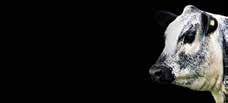
The BFO will not sell, trade or otherwise share its Ontario Beef mailing list under any circumstances. A service may be provided whereby items are submitted to the BFO and mailed internally with the magazine but all materials must be approved by and acceptable to the BFO. In rare instances where external, non-commercial organizations, like the provincial or federal government, wish to use the Ontario Beef mailing list to distribute information, the government must provide their mailing materials in a finished format to BFO and/or its mailing house. BFO will then coordinate the mailing, at the requesting organization’s cost, thus maintaining confidentiality of the list. In cases where the BFO may commission a mailing, the company providing the service is required to sign a mandatory confidentiality agreement.


Subscribers to the Ontario Beef mailing list who wish to have their names removed, should call 519-824-0334 or email bethany@ontariobeef.com. Please allow 15 business days to allow us to update our records accordingly.


BFO’s complete privacy statement, covering areas of information including the electronic update system, Website, membership list and market information can be viewed on its Website at http://www.ontariobeef.com/privacy.asp



ONTARIO BEEF • OCTOBER 2022 41 Advertise in BEEF BUSINESS LEADERS Very reasonable rates! Deadline for December 2022 issue is November 15. Call 519-763-8833 for information Carl Wright Cell: 519-369-7489 Ben Wright Cell: 519-374-3335 Laurie Wright Ofc: 519-369-3658 R.R#1, #402144 Hanover, ON N4N 3B8 Tel: 519-369-3658 Wright’sJames & Joan McKinlay R.R. 1, Ravenna, Ontario N0H 2E0 Tel: 519-599-6236 jmckinlay@bmts.com Breeders of Quality Cattle Simmental • Red Angus • F1 Crosses Silver Springs Farms Sunny MeadowsCharolais CHAROLAIS BULLS FOR SALE • Double Polled • Low Birth weights • Quiet Disposition • Well grown and ready to go to work Andy Millar 109 Bulmer’s Rd. • R.R.#2 Fenelon Falls • ON K0M 1N0 • Tel: 705-887-5142 P: 519-760-0892 E: uspecs@roievents.ca FB: UNDERHILL SPECS Performance live/frozen genetics available! Commercial Angus Purebred Red Angus Purebred Black Angus Purebred Hereford The Seed Family • Greg: 705-648-4274 seesonranch@outlook.com 845040 Morrow Rd, New Liskeard Ontario, P0J 1P0 Garry & Sheila Smart 137606 Grey Rd. 12, RR # 2, Meaford, Ontario N4L 1W6 Phone: 519-538-4877 Cell: 519-372-7459 smartlimo@bmts.com www.smartlimousin.com Breeding Stock Available at All Times. “Industry Accepted since 1978” SUNRISE ANGUS (since 1995) Purebred Black Angus Cattle Bulls and females sold private treaty Consigning to Bluewater Angus Sale in October Joel & Irene Thomas • 477285 3rd Line Melancthon ON L9V 1T5 Phone: 519 925 5661• Cell: 519 940 1258 Email: sunriseangusfarm@outlook.com SPECKLE PARK HUGH MACNEIL 519-861-2722 hugh.macneil@outlook.com 322 Burt Road St. George, Ontario N0E 1N0 Embryos and Live Cattle for sale. SILVERTIP Gates, Hutches, Fencing, Scales, Chutes & More sales@steelheadag.com • 519-266-6877 • www.steelheadag.com 8669 Concession 6 Listowel, ON N4W 3G8 Pete Coleman Brantford, ON Cell: 519-865-3453 pete.bridgeview@gmail.com www.qualityseeds.ca 8400 Huntington Road, Vaughan, ON 1-877-856-SEED (7333) • Fax: 905-856-7509 Where Quality Counts Simmental Bulls is our Business & Heifers that can Produce them WAYDAMAR SIMMENTALS Contact: Dave: 519-375-0122 Josh: 519-362-5373 • Grant: 519-387-0429 Black & Reds • Performance • Ultrasound Tested
FARM & FOOD CARE ONTARIO Livestock Transportation Emergency Training Continues
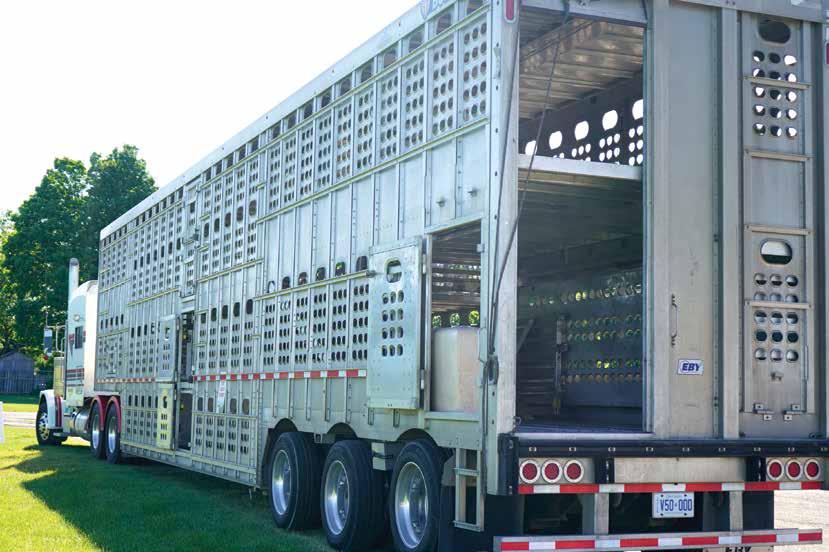 By Amber Anderson, Communications Manager, Farm & Food Care Ontario
By Amber Anderson, Communications Manager, Farm & Food Care Ontario
In 2022, Farm & Food Care Ontario (FFCO) has continued holding training sessions for first responders to walk them through what to do in the event of a livestock transportation emergency, such as a truck roll-over, or a crash involving animals on their way to another farm or market.
“Making sure first responders know what to do if they come to a scene that involves livestock- whether its cattle or hogs or poultry, at whatever age- is invaluable. While responders are very well trained for most types of accidents, those that involve livestock present unique challenges. We want to make sure that if such an emergency does arise, with some pre-planning and knowing where they can get resources such as penning panels or low-slung trailers in their area, they are better prepared for an incident. With this training, the animals involved in the accident will be cared for in a timely manner,” stated Bruce Kelly, FFCO’s Program Consultant for this training program.
The course is delivered by Kelly and large animal rescue expert Victor MacPherson. It is designed for first responders and emergency personnel and covers factors that are important to the decision-making processes for accidents involving livestock trailers, including trailer design and the implications for extrication points, animal behavior related to stabilizing the animals and easier re-loading, laws and regulations, euthanasia protocols, and how to develop response teams.
So far this year, 570 first responders - mostly firefighters - from such locations as Listowel, North Bay, Carling, Huron Shores, Norfolk, Wellington North, Stratford and others across the province have received the training.
The course has been offered since 2018. With support from sponsors such as, Heartland Farm Mutual, Trillium Mutual Insurance, Northern Ontario Livestock Innovation Alliance and the Beef Farmers of Ontario, the program has really taken off in 2022.
“The feedback from the first responders taking the training has been overwhelmingly positive,” stated Kelly. “It’s a really valuable tool for them to have in their toolbox when keeping their communities safe.”
In addition to this training, a need for targeted information for farmers who truck their livestock was identified. FFCO has created a fact sheet which includes templates where you can fill in resources available along your route. In an accident, a driver may not be able to help find resources and information stored on a cell phone may not be readily available to first responders, so a printed sheet is a valuable resource. The Farmer Trucker Guide can be accessed by visiting www.farmfoodcareon.org/download/livestock-transportation-emergencies
If you have a connection to local first responders who would be interested in arranging training, contact Bruce Kelly at bruce@farmfoodcare.org. OB









Buy a Bsimmental uy a simmental from an fOSA rom an OSA member and mget ember and get your yname our name entered into ea ntered into a draw for 1 of d6 raw for 1 of 6 $500 $prizes! 500 prizes! A s h t o n C o l v i n O S A M e m b e r S e r v i c e s M a n a g e r m e m b e r s e r v i c e s . o s a @ g m a i l . c o m 5 1 9 3 5 7 6 7 7 5 1 4 2 2 C o n c e s s i o n 4 T e e s w a t e r , O N N 0 G 2 S 0 Www.ontariosimmentalassociation.com OntarioSimmental Association $20 each or 3 for $$50 20 each or 3 for $50 Draw #1: October 29, 2022 at Keady Livestock Market at the OSA Simmental Influence Feeder Calf Sale for a Cross Five Cattle CoolerPortable Vaccince Cooler Draw #2: at royal winter fair for a pitboss 820d3 smoker Tickets can be Purchased from OSA Board members or Ashton with Member Services. Etransfers accepted at : payments.osa@gmail.com Proceeds from Raffle being used for expenses towards hosting Canadian Simmental Association AGM and Jr National Show in Ancaster, ON, August 2023

And that’s why we’ve moved away from a third-party provider and brought tag sales in-house. This shift allows you to buy closer to the source, access any approved tag on the market and shop from anywhere, anytime. l CCIA Webstore is always open l Our shelves are never empty l “NEW ” Schedule a warehouse pickup l “NEW ” Special promotion codes for purchase l Same shipping promise as beforeCCIA CANADIAN CATTLE IDENTIFICATIONanadaid.ccAGENCY a We’re taking the bull by the horns Is it a good idea to take on tag distribution? We think so! Visit our webstore and join over 7,000 producers who are already enjoying the convenience of ordering tags and accessories online. Need help? tags.canadaid.ca | 1-877-909-2333




































 By Robert McKinlay, BFO Producer Relations Specialist
By Robert McKinlay, BFO Producer Relations Specialist


















 By Lilian Schaer for the Livestock Research Innovation Corporation
By Lilian Schaer for the Livestock Research Innovation Corporation













 By Bethany Storey, BFO Communications Specialist
By Bethany Storey, BFO Communications Specialist
 By Jaclyn Horenberg, BFO Senior Producer Relations Specialist
By Jaclyn Horenberg, BFO Senior Producer Relations Specialist



 By Gina Teel, Manager, Stakeholder Communications, Canada Beef
By Gina Teel, Manager, Stakeholder Communications, Canada Beef

 By Jacques Van Zyl, DVM, Metzger Veterinary Services
By Jacques Van Zyl, DVM, Metzger Veterinary Services



















 By Amber Anderson, Communications Manager, Farm & Food Care Ontario
By Amber Anderson, Communications Manager, Farm & Food Care Ontario









